




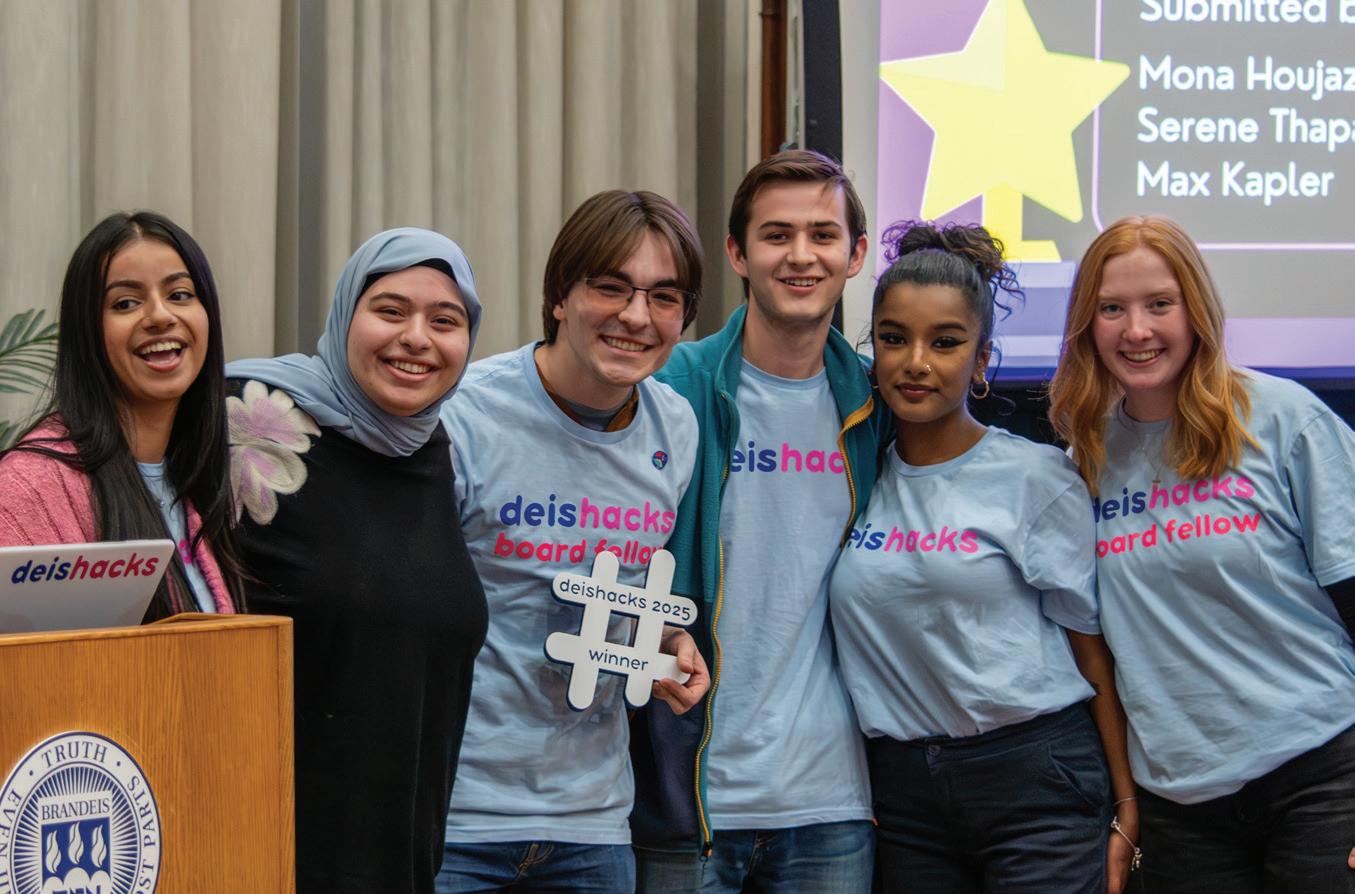
■ Brandeis undergraduate and graduate students spent a weekend supporting non-profit organizations in the Waltham community.
From Friday, Jan. 24 to Sunday, Jan. 26, members of the Brandeis community took over Farber Library in order to make a difference in the operations of non-profit organizations in Waltham. DeisHacks, “an annual social justice hackathon … [is] sponsored by Brandeis International Business School, [and] brings together students, faculty and community members to tackle challenges faced by local nonprofits.”
This hackathon lasted for 48 hours, as “teams collaborate[d] to develop solutions for real-world problems in areas like education, healthcare and housing, fostering creativity, technical skills and social impact.” The 2025 hackathon theme was Design for Community, Design for Impact.
On Jan. 24, participants arrived at Farber Library at 5 p.m. to check in and join the discord, which is the primary form of communication for everything DeisHacks. They then convened in the Rapaporte Treasure Hall for the opening ceremony. Following the ceremony, all participants dispersed to form their teams for the hackathon.
Each team is made up of a DeisHacks board fellow and three to six other participants. The board fellows each represent a different nonprofit organization and are students in the BUS 297C: Leadership Internships in Social Impact Organizations Class. They spent all of fall semester connecting with their organization and preparing for the hackathon. Brandeis students from all walks of life served as board fellows, including Waltham Group President Natalie Saltzman ’25.
In correspondence with The Justice on Feb. 10, Saltzman stated “With around 15 board fellows, the class is small, allowing for meaningful connections and collaboration with others. As a sociology major, this course has also been impactful in expanding my understanding of the quantitative side of things.” When reflecting on the intersectionality of the competition, she explained “This experience also tied in closely with my role as president of the Waltham Group. I had the opportunity to see many of the leadership skills I've developed come to life during Deishacks. I also work directly with the [Community Day Center of Waltham] through the Waltham Group, so this long standing partnership has been invaluable in understanding their challenges.”
Saltzman had the opportunity to represent CDCW as their board fellow, connecting the class with one of her main extracurriculars at Brandeis. Through this, she was able to leverage her preexisting relationships with their leadership team while working on her project. Saltzman explained, “for our Deishacks project, we developed a resource database to
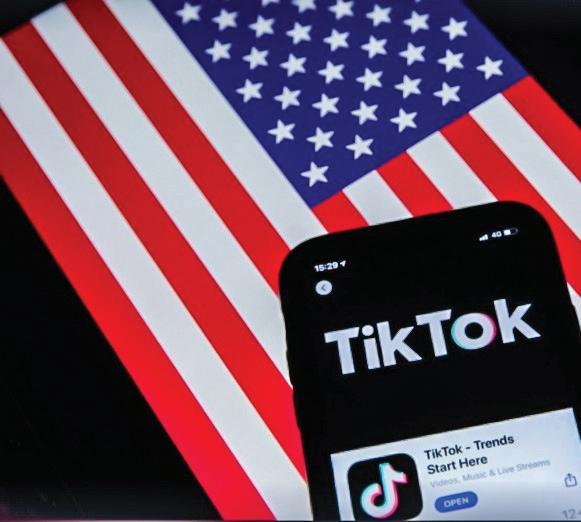
assist them in securing funding and resources for their Mission Metrowest 5k event in late April. While we didn't win a prize, the CDCW was thrilled with the product we created, and that, in itself, felt like a significant reward.”
The hackathon was co-founded by senior lecturer Ian Roy (BUS) ’05, who currently serves as the Event Director as well as the professor of the class. Roy’s leadership team is made up of many individuals, including students. On the student side of the team, Erica Hwang ’25 came back to DeisHacks for another year as the Head Project Manager, with Co-Project Manager Avery Bishop. In correspondence with The Justice on Feb. 10, Hwang shared “It warms my heart to see the incredible dedication and creativity students pour into their projects. The energy and passion throughout the weekend were truly inspiring, and it was amazing to watch teams become so deeply invested in the nonprofit missions they were supporting. Seeing their ideas evolve and take shape in such a short time is a reminder of how much impact can be made when innovation meets purpose.”
Hwang’s former Co-Project Manager Vincent Calia-Bogan ’25 joined the hackathon in a different role this year, serving as the board fellow for Charles River Community Health. In a correspondence with The Justice on Feb. 10 he explained, “Having been a part of this program for four years now, I’m thrilled to see where it is now … I can’t wait to see where future classes take it into the future.” CaliaBogan’s team ended up winning the entire hackathon with their “checklist initiative designed to both formalize some procedures as well as provide more regular employee feedback to the whole company. Specifically, [they] designed a survey in qualtrics and used Application Programming Interface access to auto-populate a google sheet, which in turn is built to automatically update statistics in real-time as well as run Natural Language Processing to provide a sentiment score and clustered words or phrases that employees are reporting in the short answer sections of the quiz.” The goal of the project was for this to be done entirely automatically, “making the analytics of feedback data easy so that the institution can be more nimble when it comes to employee concerns and retention.”
Following the formations of the teams, groups had the rest of Friday night, as well as all day Saturday, to work on their projects. Participants had a variety of workshops at their disposal, gaining the opportunity to learn new skills that would benefit their projects. Projects were due at 11 a.m. on Sunday, giving ample time for judging prior to the closing ceremony in the Rapaporte Treasure Hall at 5 p.m. At the closing ceremony, many projects and the winner were honored. Waltham Mayor Jeannette McCarthy was in attendance. She is quoted on the Deis Hacks website as stating “I was inspired by the ideas the students came up with for our local nonprofits. It’s refreshing to see that type of brain-power. They combined heart with brains and that’s a wonderful com-
Prof. Gary Jefferson (ECON) discusses the social and political implications of the 2025 TikTok ban.
■ The faculty met on Feb. 7 to discuss the state of their graduate programs and hear from Institutional Advancement as well as Interim President Levine
By ANNA MARTIN JUSTICE EDITOR IN CHIEF
On Friday, Feb. 7, faculty gathered in the Rapaporte Treasure Hall for their monthly meeting. The meeting began with a presentation from Graduate School of Arts and Sciences Dean Charles Golden. Golden presented on cuts to open admissions spots this year, explaining that they are “going for roughly 55 admissions across GSAS.”
Golden also explained that “The master's programs are incredibly important to us as a university” and will be “ more flexible or as flexible as we can with financial aid.” He added that programs and departments will aim to work together “to make it affordable for our students, for new students to join us.” This led to a discussion of the implementation of the Collective Bargaining Agreement, as new requirements have been put in place. Golden described it as “making the best of a difficult situation,” as “we did not have a prior model that allowed us to accommodate the new CBA requirements, up to 20 hours maximum.”
Golden stated “as GSAS, we are more able to recognize the different level of work put into different [Teaching Assistant] assignments and I think going forward into the fall we’ll be much more prepared for how we are able to think about those.” Currently, the standard is one teaching assistant for every 30 students. He concluded his presentation by explaining that they are in discussions with the graduate student union, stating “we are going to be more creative, we are going to try to be flexible.” He also assured all faculty in attendance that “we are not alone in this,” referring to the need to increase revenue in order to increase admissions. “We are a small university committed to being an R1 institution,” Golden stated.
The first professor to ask a question was Prof. James Haber (BIO) who inquired further regarding the R1 status of the University, and how the cuts in graduate admissions would affect this status. In a Feb. 7 exchange with The Justice, Haber explained “It is a concern but certainly not an immediate one.” He highlighted Golden’s response to his question by stating “as the Dean of Graduate Studies said, the danger to lose R1 status would only become a problem if (a) Brandeis did not increase its graduate enrollment back to about 70 (from 55) and (b) only after 5-6 more years from now, since the present cohort of grad students will fulfill the expectations of number of degrees.” Haber also explained “As the Dean said, this concern would assume that the Carnegie Foundation did not reduce its expectations, in view of the fact that a number of R1 schools have reduced their admissions numbers this year.”
The Carnegie Foundation defines R1 institutions as a school that meets “a threshold of $50 million dollars in research expenditures and 70 doctoral research/ scholarship degrees awarded.”
In an email exchange with The Justice on Feb. 6, Golden assured that “We are not close to losing R1 status. We continue to meet the Carnegie Classification for doctorate granting universities with very high research activity. As Interim Pres. Levine made clear in his message to the community on January 17, graduate education and research excellence are central to our mission as a university, and deeply intertwined with the liberal arts and undergraduate experience. This will remain true as we strengthen graduate education and build towards the future.”
Speaking next was Prof. Rebecca Torrey (MATH). Torrey stated “The university is telling us that we have to have our Ph.D. students grade for 20 hours a week, four hours five days a week of grading. Can you imagine? Can you imagine trying to finish a math Ph.D. in five years when you’re doing this? This is more than double the work that our graduate students have done historically.” She also explained that the same 20 hour restriction applies to research assistants, however “the 20 hours for research assistants is 20 hours that's going towards their progress towards degree, and so grading an undergraduate math class is great for a lot of reasons but is not helping our grad students progress towards their degree at all.”
Torrey shared that “our graduate students are actively talking about leaving the university.” She later confirmed this statement in a Feb. 10 exchange with The Justice. Torrey explained that Brandeis keeping its status as an R1 institution is based on graduation rates. She highlighted how hard it is to graduate if graduate students are expected to do this much work

Is "Emilia Pérez"
MAEVE COAKLEY
on top of being a student, and encouraged meeting attendees to sign a petition created by these graduate students.
Prof. Dmitry Kleinbock (MATH) spoke in solidarity with his department, as the undergraduate advising head. He began by stating “I don’t know how many people were here in 2008, probably some of you were,” and sharing that due to the financial concerns at the time, Brandeis either needed to cut graduate admissions in half or skip a year entirely. Kleinbock stated “At that time we chose to skip a year. It was a disastrous year, we didn’t have any graduate admissions, everything was very bad, but that is what we chose because cutting admissions from our five to six slots to essentially two is not sustainable.” He explained that one of the three spots for graduate students in the math department comes from a donation, “so the school now only supports two slots.”
In an email correspondence with the chair of the mathematics department, Prof. Jonathan Touboul (MATH), Touboul shared “Here are the facts. The math department used to admit between [five] and [six] graduate students all funded by GSAS for many years, and the program has been incredibly successful. This support dwindled in the past two years and was reduced to [two] GSAS-supported students this year.” He further explained, “the University allowed to admit [four] graduate students this year, [two] funded by GSAS (so, down from the steady [five] to [six] admissions by a fact of [two and a half] to [three]), one funded by the Palais donation, and one admission which will only exist if we can find money to support it.” Golden responded to these statements by reiterating that he “[does] not have the increased revenue that we need to bring in more students this year, [he thinks] everybody is aware that we do not have enough doctoral students.” Golden also explained that he is an “enthusiastic supporter” of the decision to not add additional doctoral graduate programs at this time, instead focusing on the already existing ones.
Prof. Amy Singer (HIST) joined the meeting via Zoom and stated “everything that my colleagues in mathematics have said holds true for the history department as well.” Singer explained that due to these cuts the program doesn’t have enough teaching assistants, nor does it “have enough people to make a sustainable cohort.” She explained that one of the aspects that makes the history department so special is the small but coherent group of students that they are in danger of losing. Singer also explained that the department has “had its own endowment that helps sustain the program for over 50 years and that endowment is now being parceled out in a somewhat more parsimonious manner. Why the University no longer lets it function how it was intended, which was to help us be competitive and recruit students.” Singer concluded her statement by sharing “none of us are suffering more or less than the others but this is a university-wide problem, and so what we need are not necessarily individual siloed solutions, but we need university-wide conversations, about sustaining our R1 status, about sustaining viable and healthy thriving programs.”
Following this presentation, the faculty members were greeted by Jordan Tannenbaum ’72 and Stephen Rodriguez from the department of Institutional Advancement. Tannenbaum introduced himself, explaining that the department is “committed to a comprehensive campaign, a comprehensive campaign will include capital, endowment and annual.” He explained that he has “great hopes for this campaign and [believes] it will be a success.
Tannenbaum then moved into a short explanation of his qualifications for the faculty, sharing that he ran a very successful capital campaign at the Holocaust Museum that took place over 10 years. He shared that the goal for fundraising this year is one hundred million dollars, and he has “every reason to expect that we will hit our goal this year.” To conclude his presentation, Tannenbaum shared that the University is entering the quiet phase of the campaign, and all can expect it to get “louder” in the spring of 2026. He explained that the first thing on his list is working to receive the funds that are necessary to “achieve Arthur’s vision.” Rodriguez explained that they have raised $53.4 million so far this academic year, putting them just over halfway to the final fundraising goal as they move into the second semester. Rodriguez stated that “the real stars of the University are our faculty and our students.” He shared some main fundraising highlights of the year so far, speaking about the Engineering Science Program which has reached the seven figure level. Rodriguez stated “this is unheard of for a program that has no alumni yet.” He also highlighted an 18 million dollar gift from a faculty emeriti, and a 1.2 million dollar gift that was received from the “single largest taxpayer in the United Kingdom.” According to Rodriguez, this was the “first gift to say hello” as See MEETING, 5 ☛
On Feb. 9, the Student Union Senate’s first meeting of spring semester was called into order by vice president Ria Escamilla-Gil ’27. The meeting was composed around granting clubs probationary status, budget concerns and chartering clubs.
The Senate first heard from the National Society of Black Women in Medicine, a club seeking probationary status at Brandeis University. The presentation was given by President Ciara Patterson ’27, Vice President Paris Weaver ’27 and Treasurer Gail Amankwah ’27. This national club has 34 chapters and was founded at Florida State University on Oct. 14th, 2017 by Amber Balkcom and Ashlei Phillips. Their mission is to increase retention of Black women pursuing broad careers in medicine. The club has already had campus engagement
Jan. 31—There was a medical call for a party with a high fever. They were treated by BEMCo and transported to a nearby hospital for further care.
Jan. 31—There was a medical call for a party having difficulty breathing. They were treated by BEMCo and transported to a nearby hospital for further care.
Jan. 31—There was a medical call for a party having an allergic reaction. They were treated by BEMCo and transported to a nearby hospital for further care.
Feb. 3—There was a medical call for a party having back spasms. The patient was treated and refused further medical care.
Feb. 3—A party was experiencing a mental health crisis. They were transported to the Brandeis Counseling Center.
through a vision board workshop and are currently working on future events including a medical ethics panel and an upperclassman talk. The club promotes academic excellence and is voluntary. It was granted probationary status.
Next, the Senate heard the Student Union Budget Request for 2025-2026 done by Head Treasurer Xan Maddock-Mark ’25. They discussed adding a transportation fund for students to apply for and use to compensate for their travel to and from internships and jobs off campus. The Student Union Budget was approved.
Executive Senator Club Support Community Chair Daniel Shin ’27 discussed the process of de-chartering clubs. Students Talking about Relationships is an inactive club on cam -
Feb. 4—There was a medical call for a party who had fallen and injured their thumb. The patient was treated and refused further medical care.
Feb. 5—There was a report of a party who had fallen on the Rabb Steps and was refusing medical attention. The party was unable to be located.
Feb. 6—There was a medical call for a party who had been injured playing basketball. The patient was treated and refused further medical care.
Jan. 31—A party reported a possible phone scam.
Feb. 1—There were reports that the walkways were starting to ice up. The appropriate parties were notified.
Feb. 4—Lights were not working behind Gosman Sports
pus, and after reaching out to those who used to be involved, it has been established they are no longer meeting. Therefore, the Senate approved the de-charter.
The Senate briefly reviewed the executive board report and finance report. Afterwards, they discussed the new system for committee chair updates for future meetings, which involves directly contacting Escamilia-Gil. Escamilia-Gil ended the meeting by requiring all committees to have their first meeting before Feb. 16th.
— Kelsey Stevens
and Convocation Center.
Feb. 4—Facilities were notified to have the sidewalks salted.
Feb. 5—A party reported that a car backed up into another car in the South Residence Lot.
Feb. 6— “Death to America” was found written in the snow on a picnic table outside Goldfarb Library.
Feb. 6—Facilities were notified about slippery walkways.
Feb. 6—A party reported hearing screaming from Massell Quad.
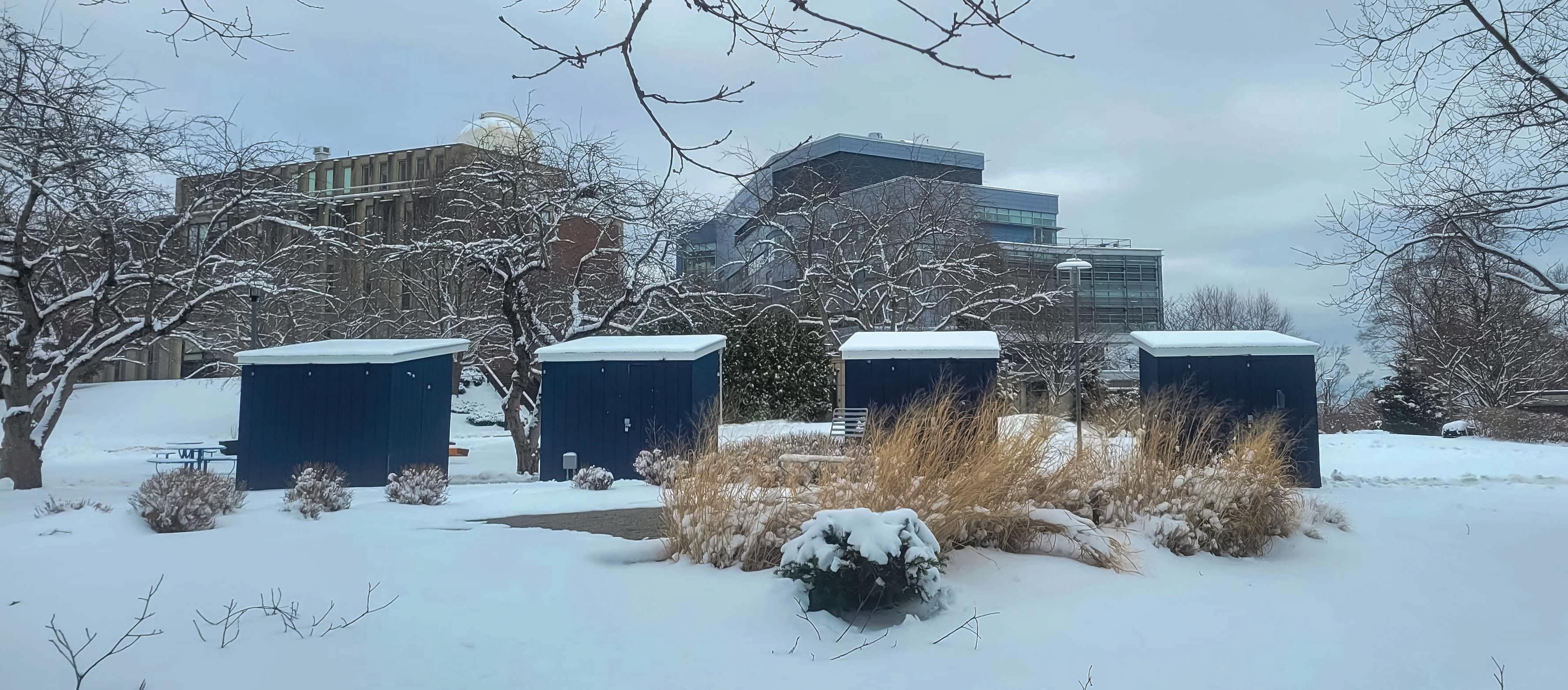
■ A news article incorrectly spelled a name as “Troyanvosky” It was corrected to “Troyanovsky.” Feb. 4, Page 1).
■ A features article incorrectly wrote that a knit bag was filled with “cotton”. It was corrected to “deadstock waste wool.” (Feb. 4, Page 7).
The Justice welcomes submissions for errors that warrant correction or clarification. Send an email to editor@ thejustice.org
The Justice is the independent student newspaper of Brandeis University. The Justice is published every Tuesday of the academic year with the exception of examination and vacation periods.
On Feb. 9, Rabbi Seth Winberg sent an email to the Brandeis community with the subject line “Addressing Misinformation About Hillel at Brandeis.”
Winberg began his email by thanking the community and student volunteers for the most recent Shabbat dinner, which reflected the strength of the Jewish community at Brandeis. He then addressed rumors that Hillel at Brandeis is assisting “a group of students identifying as the ‘Jewish Bund.’ Winberg encouraged everyone to “approach rumors with skepticism and verify information before accepting it as fact.” He then clarified that the Jewish Bund, which he called an “antiZionist” group, does not receive recognition or support from Hillel nor is it recognized as an official Brandeis student organization.
Winberg also mentioned that the Jewish Bund has conducted activities in Farber Library “that many students have found disruptive, hindering its function as a space for focused study and scholarship.” He then stated that some individuals connected with the Bund had misrepresented Hillel, and mis-
used Hillel’s space reservations, and that Hillel is “exploring appropriate steps in response.”
Winberg recognized that as a campus rabbi and Hillel professional, “misunderstandings about our role are inevitable.” He expressed Hillel’s “deep commitment to nuance and education, as well as our unwavering support for Israel as a Jewish and democratic state with safe and secure borders.”
The email closed off with a reminder that “Hillel remains committed to fostering a welcoming, vibrant, and supportive Jewish community” as well as a campus where free expression is upheld. Winberg encouraged students with concerns about “community standards, harassment, or discrimination” to report them to the University.
Justice editor Bryan Wolfe ‘27 is employed by Hillel and did not contribute to this article.
■ Students and community members gathered to express their sentiments regarding the lives lost from military confrontations in Gaza and Lebanon.
By JULIA HARDY and SOPHIA DE LISI JUSTICE ASSOCIATE EDITORS
On Wednesday, Feb. 5 the student organization Jewish Deis Bund hosted a vigil to “honor and remember those murdered in Palestine and Lebanon,” as announced in an Instagram post on Feb. 4.
The vigil was held in the Shapiro Campus Center Atrium, with students filing into the space at 7:00 p.m. The speeches started shortly afterwards. As a group of about 65 students formed a semi-circle around the speakers at the base of the stairs, one student handed out flyers with images of Palestinian children who died throughout the conflict. Most participants wore face masks.
Before the speeches started, the crowd was encouraged by Jewish Bund organizers to “not block any walkways,” and to “please leave with a buddy.” Participants were also told to walk away if a police officer approaches them.
Approximately 10 individuals spoke. The beginning speech began with references to the deaths in Palestine and the need for action. The speaker stated that “the death toll of Gaza is an estimated 60,000 people” and discussed the effects of the attacks on Palestinians. At the end of the speech the speaker expressed a need to continue conversations about the effects the Israel-Hamas war has had on Palestinians. In their words, “... We must continue to talk about the way that the United States has continued to let it all happen. And we must continue to talk about what we can do.”
Additional speakers echoed these sentiments, with one individual referencing the statement, “mourn the dead and fight like hell for the living,” which was used in light of the Oct. 7 attacks. The statement originated from Mary “Mother” Jones, a labor and union organizer active in the early 1900s. At the time, Jones was fighting “to improve the lives of miners and silk mill workers.”
That same speaker also talked about why the participants were there in the first place, saying, “We should know what it means to love a land. We should know what it means to love the people and to love the community in the land. And that is why we are all here today. Because the fight did not begin on October 7. We did not start mourning on October 7.”
Before opening the floor for more speakers, a member of the Jewish Bund began discussing a list of demands that their organization has for the University. As an introduction to the demands, the speaker said, “We’re tired of individuals being unmet. We’re tired of having our comrade’s families get murdered [while] the University [just] doesn’t care or empowers those who are involved in the killings. And our university is deeply implicated in the Israeli state occupation, and so is our tuition.”
The first demand centered around the November 10, 2023 “protest” that took place after the de-recognition of the Brandeis chapter of Students for Justice in Palestine. The Jewish Bund wanted a “formal apology” from the University to the students who were “beaten and arrested” as a result of the protest. Accordingly, they called for the rechartering of Students for Justice in Palestine and the reversal of the free speech policy the University clarified the morning of the protest in an email from the Vice President of Student Affairs, Andrea Dine and the Chief Officer of Public Safety, Matthew Rushton. Dine and Rushton explained that the use of chants such as “from the river to the sea, Palestine will be free” and “intifada, intifada,” are prohibited. They said that per the University’s Free Speech and Free Expression Principles, they are examples
of “speech that constitutes threat or harassment.” Thus, the Jewish Bund demanded the University repeal this policy because they feel it violates the First Amendment’s assurance of free speech.
The next demand was for the University to release a “declaration of support of the right of return for Palestinians to historic Palestine.”
The Bund also called for a meeting between Interim President Arthur Levine ’70, University administration, students of color, international students, women and queer students to create a “functional plan to defend their rights” as the Trump administration’s policy became more restrictive towards the groups. Furthermore, they demanded the University release a public statement of condemnation of President Trump’s “racist, radical, anti-immigrant, anti-humanity, anti-queer, anti-woman, policies and rhetoric.” Along with this statement, the Bund demanded the University give a public statement “for the U.S. security control and removal of all Palestinians of Gaza, an ethnic cleansing of 2 million people.”
Another demand was “a direct line of university communication for all students advocating for environmental, feminist, anti-colonialist, anti-racist, anti-imperialist and anti-Zionist policy.”
Lastly, the Bund called for the University to provide full financial transparency.
Beyond the demands aimed towards the University, other speakers also alluded to Brandeis’ role in the Israel-Hamas war.
“I’m the last Palestinian student on campus for a while,” a speaker introduced themself. They discussed how they are still processing the impacts of the war. “I don’t believe in Brandeis, the social justice school that we all came to. As much as I learned at Brandeis, as many amazing people as I met, including a lot of you, I don’t believe in any of that anymore.”
They shared that they are still comprehending the events of the war, particularly as it relates to the loss of their loved ones. The speaker said, “It’s like I’m finally starting to process everything that happened in the last 15 months, it still has not hit me in the way that I thought it would. I still don’t understand that a lot of people that I absolutely love and cherish are gone.”
The speaker discussed the pain of losing their close friend and family members to the violence in Gaza. They talked about the “unjust world” that it “did not just shut up and walk away with taking 34 members of my family, but also the person that I loved most in the world, the person who I was waiting for graduation in three months, just to show him that ‘this is what you did. I am here because of you.’”
Looking to a world post ceasefire, the speaker talked about the continued violence, “They’re attacking my family, the last remaining people of my family, the people that I call home. Even though the war is over, there’s a deal, they got the hostages back, we’re still being attacked.” They said that the Israel Defense Forces are demolishing family homes and blocks of housing.
Additionally, the speaker referenced President Donald Trump’s Feb. 4 news conference where he suggested the resettlement of displaced Palestinians outside the territory and the United States to “take over” the Gaza Strip. He proposed a U.S.-led redevelopment of the land, saying that “We’ll make sure that it’s done world-class. It’ll be wonderful for the people … Palestinians, mostly, we’re talking about.” During this news conference at the White House, Trump was accompanied by Israeli Prime Minister, Benjamin Netanyahu.
The same speaker asked vigil attendees, “Who the hell does [Trump] think he is? Has he not learned anything about Palestinians?” They spoke of Palestinian resilience, “We cry our eyes out, but then we wipe our tears [with] one hand, and we use the other to rebuild our homes, to raise our children, to teach them what’s right and what’s wrong, to show them that this land is ours and it will always be ours.”
Another speaker criticized both Trump’s announcement as well as Former President Joe Biden’s role in the conflict. They
warned vigil attendees not to be “fooled by the promises and lies of liberals and the Democratic Party,” referencing how Biden said, “If there wasn’t an Israel, we’d have to invent one.”
“Why is that?” The speaker asked. “To represent the interests of American capitalism in the Middle East. They are not looking for solutions and they will never be as long as they are receiving massive profits and donations …” They added that “Gaza is in ruins with two-thirds of its buildings destroyed by bombs manufactured by the United States.”
The speaker concluded by calling for a one state solution — a “unified, secular, and socialist state,” stressing a right to return for Palestinians.
A speaker turned the vigil’s attention to Brandeis Israel Public Affairs Committee’s banner hanging in the SCC, explaining why the Bund opted to cover it with a Palestinian flag for the vigil.
“Just a few weeks ago, [the Brandeis Israel Public Affairs Committee was] tabling in Upper Usdan to send more arms to Israel,” they said. “[Students for Justice in Palestine] got de-chartered for rhetoric, and they took away from many in our community an actual voice for progressive politics and we’re left with a genocidal campus group who has literal material ties to the [Israeli Defense Force], to the occupation.”
The speaker also identified a “double-standard” between the students who were arrested by police officers during the November protest for “peacefully protesting” and the students tabling for BIPAC.
“This school is very okay with supporting a group of students with a military with a state … that’s involved in serious genocide,” the same vigil speaker said.
According to its website, BIPAC is the University’s Bipartisan Pro-Israel Lobby, “dedicated to proactively discussing the issues facing Israel as well as her surrounding neighbors.”
The organization lobbies Congressmen and “looks to create a pro-Israel environment on the regional and national level” by planning programing such as discussions, speakers and communicating with other campus organizations.
In a Feb. 7 statement to The Justice, BIPAC President Jake Rosen ’27 confirmed that the organization tabled on Nov. 15 “to collect signatures to counter a congressional resolution which would halt arms sales to Israel during its current seven-front war.” He explained that BIPAC “serves to support the essential relationship between the United States and the State of Israel” and “sought not to introduce anything unprecedented but to uphold a longstanding tradition of mutual partnership” between the two. Comparatively, in a Nov. 27 Instagram post, BIPAC publicized a letter to Massachusetts senators Ed Markey and Elizabeth Warren that criticized their support of Senator Bernie Sanders’ “efforts to block weapons transfers to Israel.”
“To accuse our club’s activities of ‘genocide’ shows a clear disregard for the definition and severity of the term,” Rosen wrote. “We are disappointed to see this word being used as a baseless pejorative, as it obscures moral clarity and adds vitriol to the campus atmosphere.”
Amidst conversations about violence, politics and Brandeis’ culpability, there were sentiments of gratitude for the dedication of those who attended the vigil. One speaker expressed their thanks to the participants, “Thank you all for showing up and thank you for proving to me, after a good year and a half of bad experiences organizing on this campus, that community can be made, we can come together and we can and we can accomplish things.”
Another student speaker said, “in general, [it’s] really important to recognize that we have each other here,” expressing their desire to stand in community and solidarity as a collective. The Jewish Bund group fostered this line of thinking by encouraging participants to get involved with their efforts by joining their email list and attending meetings. Additionally, the group planned on “holding a sit-in tomorrow at the Library of Farber, anytime between 9 a.m. to 5 p.m.”
The vigil touched upon themes of grief and frustration, but students also talked about action and the significance of community.
■ After MCAS was removed as a statewide graduation requirement, changes to competency determination were approved by the Waltham School Committee
By LIN LIN HUTCHINSON JUSTICE EDITOR
During the Feb. 5 Waltham School Committee meeting, members of the committee voted in favor of establishing three pathways to meet competency determination requirements for the Waltham High School 2025 graduating class. The decision comes almost three months after Massachusetts voters passed a law eliminating the requirement that students pass the Massachusetts Comprehensive Assessment System tests in order to receive a high school diploma. Prior to the November 2024 election, the CD requirements were fulfilled by administering the MCAS, a standardized test in English Language Arts, Math and Science for high school freshmen and sophomores. Additionally, all students were required to complete both MassCore and local coursework requirements for graduation. With a 59.1% vote in favor of eliminating the requirement to pass the MCAS in order to graduate, CD is now determined by coursework at the local level.
During last week’s school committee meeting, Assistant Superintendent for Teaching and Learning Sarah Kent presented the proposal for the class of 2025. Kent explained that
in order to develop a sufficient standard proposal, the department gathered insights and data from other Massachusetts school districts, attended meetings and webinars, reviewed curricula, discussed alignment with other directors and vetted the proposal with the entire Waltham High School administrative and executive team.
The proposal included three pathways for students to meet CD. The first pathway required this year’s seniors to have passed the MCAS exams during their freshman and sophomore years. The second pathway presented allows for a combination of passing some MCAS exams and completing certified coursework to cover any missed exams. The third pathway enables students to meet the CD requirement solely through coursework that has been certified by the district as aligned with the curriculum frameworks for CD.
According to Kent, these three pathways meet the state law that outlines that to achieve CD, states’ students would have to have demonstrate “mastery of a common core of skills, competencies and knowledge.., by satisfactorily completing coursework that has been certified by the student’s district as showing mastery of the skills, competencies and knowledge contained in the state academic standards and curriculum frameworks in the areas measured by the MCAS high school tests described in section one administered in 2023.”
Kent and her department have determined that the certified courses equivalent to passing the MCAS in ELA include receiving a passing score in Grade 9 and 10 English or ESL Levels 2A and 2B courses. For Math, students would need a passing score in Integrated 1 and Integrated 2 courses, or topics in Algebra and Geometry or Math 12 Personal Finance. Lastly, the science proposal would require seniors to receive a passing score in a lab science course, such as Physics, Bio -
logy or Chemistry.
During the question and answer portion of the presentation, school committee member Liz AlJammal asked what constitutes a passing or sufficient grade for the certified courses needed to achieve a CD. Kent clarified that a ”D” is considered a passing grade.
“If we’re giving credit for it, we’re counting it as ‘mastery,’” Kent explained, noting the ambiguity in the law’s language regarding what qualifies as “mastery.”
The proposal was approved by all five present committee members.
In anticipation for the future graduating classes of 2026, 2027 and beyond, Kent shared with the with the school committee questions she and her department are considering, including if participation in MCAS will be considered as a graduation requirement for Waltham ninth and tenth graders, as test scores would still need for a student to be considered for the John and Abigail Adams merit-based scholarship and for a graduating senior to receive the Massachusetts State Seal of Biliteracy. The MCAS would help with school and district accountability, and Kent added that while the current proposal offers three pathways for the Class of 2025 to achieve competency determination, they are still exploring the possibility of multiple pathways or additional options, such as portfolios. She emphasized that further discussion will be needed, as they are ”waiting for some sort of guidance” from the state government. On Jan. 17, Massachusetts Governor Maura Healey established a K-12 Statewide Graduation Council to advise both the Governor and the Legislature on the development of statewide graduation requirements.

this donor is very interested in the work that Brandeis has done regarding antisemitism.
Rodriguez also spoke about working to get the eight and nine figure gifts for the University, as those are faster to obtain than the same amount of money from lower-scale donors. He highlighted that the “cost per dollar raised at Brandeis is seventeen cents” and explained that Brandeis has a 500,000 person database, which is a lot to get through. Rodriguez stated “we’re not asking for the check on the first date,” gaining a laugh from attendees.
Prof. Ian Roy (BUS) ’05 has been very involved in the fundraising for the Engineering Science Program. In a Feb. 10 email to The Justice, he shared “The success of the fundraising efforts for engineering speaks to the strength of the program’s vision and its alignment with the broader mission of Brandeis. This initiative was approved by the faculty in 2021 with the goal of integrating engineering with our liberal arts foundation, fostering interdisciplinary collaboration and preparing students to tackle global challenges through innovation and technology.”
When asked why these fundraising efforts in particular were so successful, Roy shared “Institutional Advancement has done an excellent job by working closely with faculty, staff and students to communicate the program’s unique strengths. Their ability to tap into a new community of supporters who are particularly excited about this initiative has been key to its fundraising success. Going forward, continuing to engage with the broader university community, emphasizing the program’s role in strengthening Brandeis as a whole and highlighting the intersection of engineering, science research, liberal arts, entrepreneurship and social impact will be important.” Tannenbaum concluded by sharing the main groups that IA is currently working on connecting with, “alumni, the Brandeis National Committee, and parents.” He called for the faculty to remain involved with fundraising efforts by sharing “development is a team sport and you are all members of the team.” Tannenbaum explained that in this quiet phase, they are “looking to folks that would be a part of campaign leadership,” referring to people who have made large donations in the past. He explained that they are working closely with marketing, and hoping to solicit the Board of Trustees, as they are the closest potential donors to Brandeis.
The floor was then opened for questions, and Prof. Sabine von Mering (ENVS/GERM/WGS) approached the microphone. She explained that she felt fundraising should be marketed as a liberal arts concept, stating that “anything they want to support on the science side for example has a connected piece in the arts and the humanities, so someone who supports engineering could also support the Lydian String Quartet.”
In correspondence with The Justice on Feb. 7, von Mering shared “It struck me as I looked at the money that had been raised for the engineering chairs this year and also at our 'four buckets' that if we are truly intent on being innovative for the "digital knowledge economy" of the future, these efforts sound far too conventional.”
She elaborated,“That's why my suggestion was that our fundraisers should approach donors with the explicit suggestion to make more interesting donations that support multi-/trans-/interdisciplinary work. Instead of faculty having to build those connections once the funds are secured, we should actually excite donors to make such donations from the get-go.”
To conclude her statement to The Justice, von Mering stated “I could see those being innovative so the donors would feel they are very "cutting edge." At the same time, such initiatives would be extremely attractive to prospective students while providing faculty with many opportunities for digital cooperation with other institutions worldwide. I am certainly seeing young scholars who are currently writing dissertations move in those directions.”
Rodriguez responded by explaining that IA is shifting from think-
ing about what they need donors to do to asking donors what they care about. Dean of Arts and Sciences Jeffrey Shoulson then took the stand, explaining some of what he had learned during approximately seven meetings with potential donors in South Florida the week prior. He stated “it is important for me to do a lot more listening than talking in some cases, to hear what matters to the donors and to think about how those align with our priorities and where some of the meshes are.”
The meeting concluded with remarks from Interim President Arthur Levine ’70. He explained that throughout the meeting “There has been a lot of talk about Arthur’s vision. I think in many respects the way I’ve put it is Arthur’s vision matters to Aurthur. To Brandeis what matters is our vision.” Additionally, he spoke on the goal of raising money effectively. Levine stated “Raising money, it’s really about listening. Meeting people and hearing what’s really important to them. What do they want to build? What do they want to make happen? We’re giving them an opportunity to build that, to make it happen.”
Levine explained that since he arrived at Brandeis, he has taken on a role as an internal president, getting to know the community. Now it is time to step outside and get more involved in the outer community, meaning that others will have to take charge of some of the more internal matters. He shared that Senior Associate Provost for Faculty Affairs Joel Christensen (CLAS) will take on the lead role in terms of his new restructuring plan. Levine also explained that three members of faculty have been assigned to each of the new four categories of the school, two from the practice and one member of administration.
In a Feb. 10 exchange with The Justice, Christensen shared “The faculty selected as conveners are meant to lead conversations about what the new units will be like. Everyone involved in leading these conversations is a current faculty member. We are not far enough along in the process to know what the units will look like or what kind of leadership they will need.” He is also one of the individuals that will be a part of each division, the Arts, Humanities and Culture section being made up of Prof. Olivier Bernardi (MATH), Prof. Harleen Singh (WGS) and Prof. Joe Wardwell (FA). The Social Sciences and Social Policy Representatives are the Director of the Lurie Institute for Disability Policy Monika Mitra, Dean Charles Golden and Prof. Aldo Musacchio (BUS). For Science, Engineering and Technology, the representatives are Prof. Sacha Nelson (BIO), Provost Carol Fierke, and Prof. Sara Shostak (HSSP). For the Economics and Business section, Prof. Sarah Mayorga (SOC), Prof. Linda Bui (ECON) and Prof. Ben Shiller (ECON) have been chosen. In a Jan. 17 email from Levine, he stated “The conveners will share what they have learned with the President, Provost and Faculty as the proposed plan is shaped over the coming weeks and months.” He also explained that Christensen will “be responsible for the conveners and collaborating with faculty and staff on re-imagining and implementing our vision for a vibrant future.”
Levine continued his address by explaining “We’re holding town meetings. I’ve been talking to you a lot but I haven't been talking to the staff and I haven't been talking to the students. In the next few weeks I will be meeting with each of those groups at town halls.” He also explained that he is trying to meet with as many departments as possible
Levine then shared with faculty that he has presented to the Board of Trustees three stages that are as follows: “stage number one is stop the cuts, stage number two: raise revenue, enrollment reports to me. And we’re going to go into a capital campaign, we have some great leadership for that. Stage three was even if we raised a ton of money it wouldn’t be enough because the world of education is changing. And we’re gonna lead it.”
Levine explained that the board asked if he wanted a vote from
them and he stated “no, you don’t get to make that decision. You have to approve it, but you don’t get to make it.” Levine however also explained that the board loved the plan and are very excited to move forward with it.
He concluded his address by sharing that there is not much that can be done regarding the admissions number from this year. Levine stated that “by the time I arrived in November what was going to happen was done. Our first chance to have a real effect is next year.” He also spoke briefly on the budget, explaining “What we’re trying to do is no cuts this year, I can’t make any promises yet but no cuts. That’s our mantra.”
The floor was then opened for questions, and a member of the International Business School faculty explained that he believed the four proposed groups need not just governance but also a structure of financial planning in order to ensure their success. Levine responded by agreeing, stating that they are still working to compile information regarding financial models.
The next speaker was Prof. John Plotz (ENG) who spoke to Fierke and EVP of Finance and Administration Stewart Uretsky with concerns regarding the recent announcement of the new Student Support Team. He explained that he had sent them a letter that received no response stating some of his concerns regarding lack of transparency surrounding the team. In this letter, Plotz explained “That is no way to build trust or foster a climate of mutual reliance and trust. Trust is at an understandably low ebb now, and it must be earned from those (students especially) who have to be shown they are not just the objects of the university’s actions, but subjects and participants in its life." This letter also brought up three questions, regarding “when will this initiative be drought to the various venues that are set up for students, faculty and staff to weigh in,” “when will the names of the members of this proposed SST be made public,” and will it be publicly stated that the SST would not have policing or reporting authority.”
Uretsky and Fierke responded by explaining that they had never received the letter and that many of these concerns had been addressed due to certain individuals being consulted prior to the announcement of this program.
In a Feb. 10 correspondence with The Justice, Student Union President Rani Balakrishna ’25 stated “The Student Union was closely consulted before the implementation of the Student Support Team by the Provost’s Office, and our executive board gave feedback and overall liked the approach and structure of the SST. Personally, I believe that the SST is a great third party, neutral group to ensure that all students are safe and following Brandeis guidelines. We are in support of it, and we look forward to the group’s effective de-escalation tactics (if need be), so that all students are supported.”
Singer then took the stand again, expressing distress as she stated “buckets are made to hold things but by definition they also keep things out.”
Levine responded to this concern by stating “the buckets that I am imagining are mesh walls,” emphasizing the collaborative nature of his new plan by sharing “what we’re doing is creating natural connections among applications and disciplines.”
As faculty left the Rapaporte Treasure Hall, they were met with a member of the graduate student union, handing out printed QR codes that lead to the petition the math department representatives had spoken about previously in the meeting.
The faculty will be busy, as in addition to the March meeting they are set to convene for Special Faculty Meetings on Feb. 28 and March 28 to continue conversations regarding the reconstruction.
CONTINUED FROM 1
bination. This event goes to show that the types of things being done at Brandeis opens doors for students and their community.” Her sentiments surrounding the positivity of the program were echoed by Calia-Bogan, as he stated “In terms of the impact Deishacks has had on me as a person: I estimate I’ve dedicated >1300 hours of my time to Deis hacks over the 4 years I’ve been at Brandeis. I’ve been involved in organization the entire time, and ran it in 2023
and 2024. It’s been among the most educational experiences of my life — I’ve learned to pitch, organize, fundraise, speak in front of my peers, navigate a bureaucracy, and so much more.” When reflecting on the four years that he has spent as a part of this impactful organization, Calia-Bogan shared “I couldn’t have imagined the heights we’d reach. To me, it really is about the community we’re all a part of. There’s an incredible joy I get connecting students to their com-
munity, and watching them realize they really can make a change in it. that was why I did it, and continue to be a part of it.”
— The Justice Managing Editor Eliza Bier was an organizer for DeisHacks and employed by Brandeis Design and Innovation and did not write or edit the article.
■ Campus leaders discuss about additional free menstrual products to be added to Skyline and Village bathrooms, as well as the future of menstrual equity on the Brandeis
By JULIA HARDY JUSTICE ASSOCIATE EDITOR
In a Feb. 4 email, Period Activists at ’Deis student club announced the “huge news” that the Pilot Program — an initiative started by PAD and Student Union — is expanding this semester. The Pilot Program originally launched in the spring of 2023 with the aim to provide free menstrual products in the first-year residence halls, including East Quad, North Quad and Massell Quad. There were a total of 52 dispensers installed in those dorms, each supplied with both pads and tampons.
The initiative is now expanding to provide free products in Skyline Residence Hall and The Village Residence Hall, with additional product holders or “caddies” in each restroom. PAD, the Student Union and The Abraham Feinberg Educational Network for Active Civic Transformation all worked in collaboration to make this expansion a reality. This project serves as the next step towards menstrual equity on Brandeis’ campus.
In a Feb. 6 interview with The Justice, Student Union President Rani Balakrishna ’25 expressed her excitement regarding expanding the initiative outside of first-year dorms. “I'm really excited about this expansion, because, you know, obviously . . . freshmen are the youngest of us. . . . But also, we want to expand it to as much of campus as we can.”
While the Pilot Program first reached the Brandeis community in 2023, its expansion is the most recent example of the advocacy work done at Brandeis regarding menstrual equity.
PAD was founded in 2019 and has worked ever since to make menstrual products accessible to the Brandeis community. According to the student organization's website, PAD “fights for menstrual justice and seeks to uplift the voices of all menstruators. We strive to facilitate access to menstrual products and education, dismantle the menstrual stigma, and advocate for policies that protect the rights of menstruators.”
Additionally, the Pilot Program is not the first time PAD and the Student Union have collaborated to promote menstrual equity on campus. Their first collaboration related to menstrual justice was in 2020 when nine free product dispensers were installed around campus, as Balakrishna explained. Now, in spring 2025, their efforts have continued and the access to free products have increased.
The president of PAD Sophie Glassman ’25, Balakrishna and Assistant Director of Research for ENACT Prof. Charlotte Powley (LGLS) all worked closely to put together a Community and Emergency Enhancement Fund proposal to finance the expansion and additional products.
In a Feb. 7 interview with The Justice, Powley explained the de-
tails of the CEEF proposal, "We purchased $3,125 worth of Aunt Flow pads and tampons. We used the additional funding from the CEEF grant to purchase caddies that we are hoping to use to expand the pilot program to increase access to menstrual products in Village and Skyline and hopefully beyond.” Balakrishna estimated that the organization purchased 23 boxes with 500 pads in each.
A large part of the funding efforts came from assessing the student need for menstrual products. The original development of the Pilot Project was based on a need demonstrated through a survey given by PAD to the Brandeis community. This survey was originally circulated in 2021, but an additional survey was sent out by the ENACT Research and Advocacy Fellows and PAD in the fall of 2024 in order to gather data for the new CEEF proposal.
The 2024 Brandeis Menstrual Product Access Survey collected data that demonstrated students’ need for increased period product access. According to Powley, there were 191 responses, and the Research and Academic Fellows Menstrual Equity Group Report outlined the findings that ultimately helped support the CEEF proposal. The survey included findings such as, “Approximately 74% of respondents indicated that the lack of access ‘has an impact on their daily lives,’” and “97% of students expressed their belief that menstrual products should be offered in all residence halls for free.”
Powley voiced another common argument surrounding the financial aspect of buying menstrual products. “We are not asking students to buy their own toilet tissue. We are not asking students to buy their own hand soap. So the argument that many menstrual equity advocates present is why should this be any different?"
Powley talked about the dedication and passion of the Research and Advocacy Fellows. She said that “The Research and Advocacy Fellows were really critical in analyzing the 2024 Menstrual Product Access Survey data and putting together the report.” Powley also emphasized the way the fellows engage with the topic. “The Fellows really threw themselves into the [menstrual equity] work and they have not been shy about the research or the subsequent advocacy efforts. They really embraced this sometimes taboo and often stigmatized subject. They have really been amazing.”
In addition to the research fellows, many others became passionate about carrying out the Pilot Project and its expansion, particularly Glassman and Balakrishna.
Glassman shared her experience on PAD in a Feb. 8 interview with The Justice. She explained that she’s “really passionate about community outreach in general and, so having the opportunity to be sort of the person that’s responsible for bringing products to various organizations within the community that serves people who otherwise wouldn’t have them is . . . incredibly fulfilling.”
Additionally, Balakrishna shared her connection with PAD has been really meaningful. “... I have, like, a special place in my heart for PAD, because I also am, like, passionate about those same things [related to menstrual equity],” the S.U. president said. Balakrishna also talked about those who volunteer to help restock the period product dispensers. She said, “…We have great [Commu-
nity Advisers] in North and Massell who are passionate about this and willing to do this on their rounds.” Additionally, there are “a couple of Student Union people and a couple of PAD people working on the East [Quad] dispensers. So that's the old system and how we're maintaining that.” PAD also provides a sign-up sheet where volunteers can sign-up to help restock dispensers. However, the reliance on volunteers can make it challenging to keep up with restocks and managing the logistics of the Pilot Project. Both Balakrishna and Glassman talked about the longevity of the program as it relates to financial barriers and student leadership. Moving forward, Glassman explained, PAD will be in charge of bearing the cost of buying new products for the existing dispensers and any expansions. “CEEF will no longer be able to fund, we were told. They don’t feel that it is realistic to continue to take out of the CEEF fund so now PAD is 100% responsible for the cost of all products. . .”
While there have been efforts to have the financial aspects “built into . . . the facility’s budget and have the school carry the cost,” that has yet to be realized, making the financial future of the project uncertain. Glassman expressed that “It’s definitely a concern of how much [money] they’re [the University] willing to give us”
Balakrishna also considered the student leadership aspect and explained that she wants to help the menstrual equity efforts continue after she graduates. She talks about the need to put infrastructure in place to help the next Student Union president. To Balakrishna, that looks like “transition documents” that outline the role as it relates to menstrual equity and other logistical aspects of the role. Glassman also considered the future of PAD saying, “In terms of it becoming a sustainable program, we need to set in the reinforcements now.” So far, the “reinforcements” have looked like new executive board members who can carry on the club after she graduates. “I’m really excited about our new e-board members . . . they are providing hope, which is a beautiful thing.”
Powley expressed her excitement at seeing the new student leadership team continue the project. “I am really excited to continue to work with PAD and the Student Union to help support menstruating students on campus. Again, there is a tremendous legacy regarding these efforts; the fight for menstrual equity is not new at Brandeis. A great deal of work has been put into this effort over the years. I see the issue of menstrual equity as an issue of educational equity and I look forward to continuing to support students and our community overall as we together strive to reach this common goal of equal access to education for all students."
Balakrishna echoed this sentiment by talking about the ultimate goal. “Obviously, [the] dream hope is to have free products . . . in every building on campus. But that's . . . five years down the road, probably. Because it's more so what's realistic to implement. And it's in increments,” Balakrishna said.
Powley, Balakrishna and Glassman all look ahead with optimism and excitement, even amidst uncertainty around the funding and organization around the Pilot Project.
Be bold, and mighty forces will come to your aid.
Nelson Mandela was freed after 27 years in prison in 1990.
Singer-dancer, Josephine Baker, served as a spy for the Free French Military Intelligence during World War II.
After the TikTok application was shut down in the United States on Jan. 18 and then restored the next day, the ban was put on halt for 75 days. Prof. Gary Jefferson (ECON) shares his thoughts on what this means on both a national and global level.
TikTok is no longer available in the Apple app store. Instead, Instagram and Facebook pop up as recommendations or replacements when searching for the extremely popular social media app.
A law banning TikTok was put into place by the Biden Administration on Jan. 19, 2025. The app was determined to be a threat to the United States’ national security. A Chinese corporation, ByteDance, owns TikTok which gives the Chinese government access to millions of U.S. users’ data and power over the algorithms that pump out videos for consumers’ enjoyment. The U.S. government argued that TikTok was allowing China too much power and control over American citizens’ lives and minds. Concerns over TikTok and its relation to the Chinese government are not new. TikTok has been under pressure for over four years. Back in 2020, President Donald Trump pushed the ban of TikTok citing its national security risks. His efforts died in the courts. U.S. District Judge Carl Nichols found that Trump’s reasons for banning TikTok were “arbitrary and capricious.”
Now nearly five years later, Congress ruled that the Protecting Americans from Foreign Adversary Controlled Applications Act be put into place. They argued that this act was for U.S. citizens’ protection and therefore supersedes any infringes it may have on our First Amendment rights. But what are they protecting Americans from and why is this protection no longer arbitrary or capricious?
Gary Jefferson, the Carl Marks Professor of International Trade and Finance and senior research associate at Brandeis University, said in a Feb. 1 interview with The Justice that it’s like “throwing darts in the dark to say TikTok is the problem.” Jefferson has spent much of his career researching and writing about China’s economy. He has taught courses relating to the Chinese financial realm and economic innovation. Jefferson co-authors articles with colleagues located in China for publications such as China Economic Review. He believes the TikTok ban is a roundabout solution to a much greater problem.
The fear surrounding TikTok originates from the idea that China could be infiltrating the algorithms of the app and inciting division and espionage within the United States. TikTok’s engineering team in Beijing released a document detailing the ways its algorithm collects data from users. Their algorithm prioritizes “retention” and “time
By LUCIA THOMAS JUSTICE EDITORIAL ASSISTANT
spent” on the app. This means it looks at which videos keep the user’s attention for the longest amount of time and then analyzes the traits of that video. The sound, images, creator and other features of the video are collected and then used to educate the algorithm on what videos will keep the user scrolling. Jefferson claims, “all social media now embeds misinformation and distortion of truth and reality.” TikTok is not the only platform where misinformation is being spread. A report done by Pew Research Center found that 64% of American adults get their daily news from social media. 23% admitted to either knowingly or unknowingly sharing something that is false. Most Americans know that “fake news” exists on social media but not everyone knows it when they see it. TikTok’s algorithmic design runs the risk of promoting falsities be -
a public good that needs protecting is truth.
“Information is being defiled and contaminated in the same way the air has been,” he said.
The U.S. government also cited the Chinese government’s collection of American users’ data as a reason to ban TikTok. The corporation that owns TikTok, ByteDance, resides within China. Under Chinese law, the government is permitted to take data from corporations in their domain. This means that data collected by TikTok and its algorithms could be harvested and analyzed by the Chinese government.
Jefferson called these fears “very hypothetical and speculative.” In 2023 the U.S. government banned TikTok from devices used for federal means. These same precautions could be taken by media outlets and other organizations that
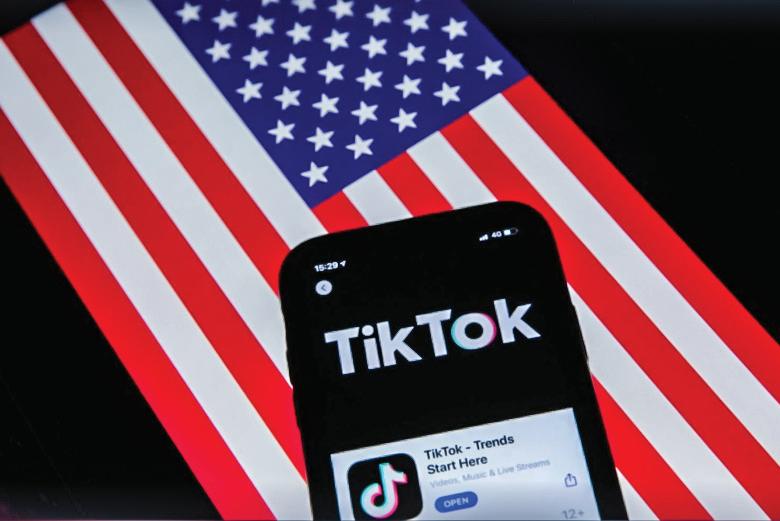
cause it is not pledged to truth. Jefferson points out that these dangers exist on all social media platforms. X, Facebook, Instagram and many others use algorithms that function very similarly to TikTok. They are all working to maintain viewer engagement, not to ensure their content is free of “fake news”.
During the interview, Jefferson explained the difference between public vs. private goods. Private goods are the ones that can be marketed like computers, college tuition or shoes. Public goods are commodities that should have no market and exist for the good of the people such as clean air, clean water or public schools. Jefferson argues that
prioritize privacy. Jefferson advocated for American users to have an educated choice on the matter. “In using social media you acknowledge and accept risks,” said Jefferson.
Jefferson thinks “spies are wonderful, that it’s important that everyone has more information and accurate information.” Countries should know, “what their adversaries are doing so that they can suitably prepare.” He would be disappointed if the U.S. did not have the capability of gaining information about China through its own “surreptitious channels” because “that’s how governments work.” He believes that this exchange of knowledge allows the world to keep itself in check.
So what problem is the U.S. “throwing darts in the dark” at?
Over the last 10 years the American people’s trust in its government and media organizations has been faltering. A study done by Gallup found that in 2024, 33% of Americans have “not very much” confidence in the media and 36% have “none at all.” In 1976, 72% of Americans had a “great deal” of trust in mass media. Similar statistics can be said for the federal government. A study done by Pew Research Center found that in 2024 only 22% of Americans trusted the government to do “what is right most of the time.” In 1964, 70% of Americans reportedly trusted the government. As stated previously, 64% of Americans get their daily news from social media. Another 2024 Pew Research Center report found that one-third of U.S. adults were on TikTok and 59% of adults under 30 used the app. It is no surprise that a large portion of the U.S.’ young population is on the app and it seems that many of them could be getting news that shapes their opinions and political ideologies from untrustworthy sources. Could it be that the U.S. government is realizing the distrust the American people — especially the younger demographic — have in it and the media and becoming frightened by the power of foreign based apps like TikTok?
While there may be some merit to these fears, banning TikTok sets a new precedent for the U.S. Jefferson predicts this ban will “tarnish the positive image of the U.S. as being free and open to choice and expression” and be “injurious to the soft power of the US as a society.” Google has been banned in China since 2010. They instituted this law as a way to produce uniformity within the country and resist the spread of “misinformation” that could inspire uprisings. Jefferson says that with the TikTok ban instated, “nationalists in China would be able to say the US is no different, they ban anything that is not American.”
With TikTok banned, other social media platforms are flooding with lost influencers looking for refuge. Instagram, Facebook, YouTube and X will become outlets for consumers of social media. X is currently owned by Elon Musk who has just been given a role in the Trump Administration as a leading force in the “Department of Government Efficiency.” This department was previously known as the U.S. Digital Service. One must wonder if other countries are considering banning X in fear of U.S. surveillance?
In her 71 years, Emily Szczypek has lived in many places. England, Australia and plenty of cities in Massachusetts have been home bases for her, but one spot eventually became home. Szczypek has lived in Waltham for 29 years, almost half her life, and she’s not hesitant to share her deep concern for the development — or lack thereof — that she’s witnessed here.
“Waltham used to be a place that anyone could afford to live in, and now it’s a place almost nobody can afford to live in — unless you’re wealthy to begin with,” she told The Justice in a Dec. 10, 2024 interview. Szczypek has always been involved with local groups in every place she’s lived. In Waltham, her groups include Bike Together Waltham, MA Audubon, Brookline Bird Club, Menotomy/Arlington Bird Club, The Trustees of Reservation and the National Wildlife Federation, among several others. She’s recently added a new recurring item to her calendar by joining Waltham Inclusive Neighborhoods, which formed in April of 2023. The group is led, unofficially but objectively, by Tom Benavides — an engineer who moved to Waltham three years ago after graduating college. Though he checks several boxes of the YIMBY stereotype — young, highly educated, techie — he doesn’t fulfill other, more consequential aspects of the YIMBY caricature. He’s not condescending or arrogant, like the critics of YIMBYism might assume, and he’s definitely not hawking unrealistic policy based solely on idealism. Quite the opposite — members of the group credit his charisma and vast knowledge of policy with getting them into housing advocacy in the first place. Both Szczypek and Debra Herman, a retired Waltham resident involved with several groups including WIN, credit him for inspiring them to learn more about the incredibly complex issue. YIMBYs are best understood by learning what they are not. The term is a response to NIMBY, meaning Not-In-My-Back-Yard, which represents those wary of affordable housing development (YIMBYs replace the “Not” with “Yes”). NIMBYs have myriad, complex reasons for believing what they do. Some worry about strain on their city’s infrastructure. One Waltham resident told The Justice in an online exchange, “The city will allow a dozen condo buildings to be erected (adding hundreds of people to the population of the city) while neglecting to increase the number of police/fire/ems [Emergency Medical Services]/dpw [Department of Public Works] personnel and improve infrastructure.”
Herman and Szczypek, however, are less focused on an unknown boogeyman entering Waltham to bother the police and cause havoc on the road. Rather, they were inspired to start advocating for housing by Waltham natives who were driven away from the city by rising costs. “I’ve seen friends have to move all the way to Rhode Island to afford to live, and continue to work in Waltham. This is my way of doing something for them,” Herman told The Justice in a joint interview with Szczypek. “This is my way of doing something for them.” Szczypek agreed, “Seeing that happen to people, it just makes me incensed.” They also both warn against homogenous communities of exclusively older or younger people. “It just doesn’t work,” Herman said. “That’s not how you create a community.” What’s the only way to get young people to stick around after completing a Brandeis University or Bentley University degree? Make housing cheap and abundant.
Herman and Szczypek credit Benavides for teaching them the logistics of the issue so they can focus on a people-oriented vision. Benavides, however, is a data machine. He first recruited another founding member of WIN, Tim Riley, by posting a homemade data map of redlining in Waltham on Reddit. Benavides’ knowledge of housing policy is encyclopedic, which makes it a lot easier to buy into the idea that creating more housing will basically solve every problem — something he steadfastly believes and backs up. He shared, “Are there downsides to legalizing more housing production? Not particularly. Most NIMBY concerns (denser housing causes traffic! Upzoning will price out existing residents! Residential
By LEA ZAHARONI JUSTICE SENIOR STAFF WRITER
development will lead to higher taxes!) are actually the opposite of the truth — traffic is bad because lowdensity sprawl forces people to drive long distances to get everywhere, increasing housing supply leads to lower housing costs and fewer evictions for existing residents and dense housing pays for its own services through property tax revenues.” It’s characters like Benavides that attract people to advocacy. They’re inspiring, staunch and persuasive — they anchor the feeling that you’re doing good work in real evidence.
They also make the more tedious parts of local politics feel urgent and important. When asked about WIN’s tangible successes as a group, Benavides and Riley both recount convincing City Councilwoman Cathyann Harris to amend Waltham’s Massachusetts Bay Transportation Authority Communities Act plan to only require one parking spot per unit instead of two. This drastically decreases the amount of land you need to build new units and allows more housing to be built with less area. “The fact that our suggestions of improving building size and reducing parking are literally the only two changes they ended up implementing — it makes me think that was our voice advocating,” Riley said. “And even if she’s not pro-housing,” Benavides added, “she’s acknowledging that we are the people to listen to.” By showing up consistently to notoriously long and inaccessible city hall meetings, WIN has made a name for themselves doing what very few other citizens are willing or even have time to do.
It’s especially important that they have, because Waltham’s MBTA Communities Act plan was drawn up by the city Law Department — made up of two people appointed directly by Waltham Mayor Jeannette McCarthy. In January 2021, Massachusetts passed the MBTA-CA as part of an economic package to address the ongoing housing crisis in the state. It requires 177 cities and towns with commuter rail stations to have at least one zoning district where multi-family housing development is permitted by-right, meaning without special permits. “Not only does [single-family zoning] cause the housing shortage, but also building multi-family housing can be profitable for property owners if they want to do that. And currently, that’s not something they’re allowed to do,” Benavides explained. In Waltham’s current zoning layout, it’s illegal to build multifamily dwellings in a vast majority of residential districts. “[Developers’] options are, if they’re in an industrial zone, they can build offices or truck depots. If they’re in a residential zone, they can build McMansions or million-dollar duplexes,” Benavides said.
So the housing problem is sorted, right? Not necessarily. Waltham’s first draft of a zoningrestructuring plan was rejected by the state in November 2024, which motivated WIN to create a plan of action. “I wasn’t holding too much against them because they [the Law Dept.] are two people with no zoning-specific, and no planning-focused expertise,” Benavides added. In this way, a vacuum of civic engagement can be a good thing — one or two civilians speaking up at a zoning meeting can really make a difference. Cathyann Harris did not respond to requests for comment, and the Law Dept. could not be reached.
WIN also embodies another benefit of local advocacy: social outlet. Along with hosting monthly social hours at Margaritas, Benavides got several members interested by just running into them in town. “There was a week last year where I saw Benavides every single day, at one meeting or another,” Herman said. “He was at the Farmer’s Market, he was at Food not Bombs, he was everywhere!” Getting involved with a cause allows for instant common ground among members, since they’re all passionate about the same thing, no matter who they are. “We have homeowners, non-homeowners. We’re all up and down through the age spectrum, which is nice. And we have different races represented. The NIMBY crowd tends to say, oh, it’s the libertarian-leaning tech guys. That’s not our group,” Riley said. The causes people join also tend to offer insight into their character and values as well. Riley, Herman and Szczypek all expressed
concern for future generations, not just themselves, as being one of their main motivators to get involved. So why are people NIMBYs? There are reasonable, surface-level worries that one might have when talking about adding a ton of population to their town. But the most enduring, and the most revelatory, seems to be an underlying fear of change. Benavides elaborated:
“The only downside [to adding more housing] is that, when we allow more housing, things will change. Our city will look a little bit different, residents will have to deal with living near construction as new housing and its associated infrastructure is built out, and residents will have to live near more people who have backgrounds different from themselves. I personally don’t consider these downsides — I love change and growth! But for many NIMBYs and existing residents, once all the factual inaccuracies are wiped away, they do genuinely fundamentally believe that change and neighborhood growth are bad.” Riley added, “The NIMBY persuasion, I have a feeling it’s just a lot of people comfortable with what they have bought into and just really not seeing the problems, I guess.”
In this way, lack of education on housing reform may be a major culprit in the survival of NIMBYism. For that, among other things, you can blame the inaccessibility of local politics compared to the complete oversaturation of national politics. Even Benavides, seemingly a titan of local knowledge, admitted he has to work quite hard to learn the amount that he does. “Waltham, a city of 60 thousand? Alas, we have no celebrities and very little news coverage. If I want to follow local politics, I can’t just find thriving discourse on social media where everyone already has an opinion and is sharing info. I have to show up to city council meetings, make public records requests, create the social media infographics, convince friends and neighbors to show up to meetings, etc. That’s a huge barrier to entry!!! I have to work ten times as hard to learn half as much about political happenings in Waltham than I do for national politics.”
Engaging locally is hard work, made nearly impossible for those working long hours or taking care of young families. Benavides continued, “It’s really hard for folks to advocate for policies surrounding housing affordability when they themselves are exhausted and struggling to pay rent on an individual level. Thus, advocacy organizations tend to be filled with folks who have the time to do the unpaid labor- for example, young professionals who make bank and older folks who are retired.” This is common — Pew Research Center found that 70% of those who have a household income above $75,000 said they belonged to at least one community group, while less than half of those making less than $30,000 said the same. WIN membership defies these trends with formerly unhoused and financially struggling members, but Benavides recognizes the importance of delivering education to low-income renters, and, eventually, NIMBYs themselves.
Though several NIMBY-esque organizations and individuals were approached for comment, none responded. YIMBY organizations have higher numbers, more accessible members and generally are enthusiastic about sharing their mission with those interested. On why this might be, Riley said, “NIMBYism is in essence the status quo. It’s only when a group of people like us identify the problem, come in, start speaking, that maybe a NIMBY opposition will form. But the default is NIMBYism.” Despite their momentum, most people tend to fear change, even when change would benefit them and the people around them. The status quo needs no advocacy. That’s why it’s important for pro-housing groups, who’ve been able to educate themselves on the beneficial power of change and growth, to make a ruckus. It’s only when confronted directly with the inaccuracies of their natural human fears that people realize the information that’s been hidden from them. All Szczypek wants, at the end of the day, is for everyone to have someplace to call home. “I’m extremely concerned about young people, or service workers at Market Basket or Star … where can they afford to live? Without them, this city has no future.”
Brandeis University
Established 1949
Anna Martin, Editor in Chief Eliza Bier, Managing Editor
Isabel Roseth, Senior Editor
Leah Breakstone, Tibria Brown, Lauryn Williams, Deputy Editors
Xilei Ceci Chen, Sophia De Lisi, Julia Hardy, Anika Jain, Dalya Koller, Mina Rowland, Associate Editors
Lil Lin Hutchinson, Zoe Zachary, News Editors
Grace Doh, Features Editor
Ariana Rich, Forum Editor
Nemma Kalra, Arts & Culture Editor
Jonas Kaplin, Bryan Wolfe, Photography Editors
Lily Chafe, Sara Samuel, Copy Editors
Marina Rosenthal, Layout Editor
Elizabeth Liu, Advertising Editor
Amanda Chen, Niámh Mullen, Social Media Editors
The All Majors Career and Internship Fair is coming up at the end of this month. Career fairs are an excellent way to connect with recruiters in person and get a better feel for companies you are interested in while learning about additional companies in the industry you are pursuing.
But Brandeis’ career fairs always seem to miss the mark. According to Handshake, this spring’s career fair is hosting 32 companies. Of these, 10 are nonprofit organizations, three are graduate school programs, including Brandeis’ International Business School, and four are in education. Six companies operate in business, finance or technology, while another six focus on government, international relations or politics. Two companies represent the healthcare and pharmaceutical industries, and one is in retail. Alarmingly, roughly 75% of them are based in Massachusetts.
This editorial is not to undermine the participating companies and is not to dismiss the fact that some students may find the event helpful. This board, though, believes that the event needs major improvements. The industries and companies represented are extremely limited.
For one, not all Brandeis students are looking to stay in Massachusetts following graduation — yes, there are many students who will pursue their paths in the Greater Boston area, but a vast number of students aim to build careers outside of both the local area and the state itself. Why is it, then, that the fair overwhelmingly features employers based in Massachusetts? It is the opinion of this Editorial Board that a career fair should reflect the ambitions of its student body and provide opportunities that extend beyond just the immediate region, introducing students to employers with national — or even global — reach.
Furthermore, Brandeis students certainly pay a costly price for their education, and because of this, many are looking for careers that offer financial stability and growth. While nonprofit work is admirable and important, it is far from the only — or even the primary — career goal for a majority of students. The fair’s heavy emphasis on nonprofit and government jobs, while valuable for an applicable few, does not cater to the full spectrum of student interests, especially for those aiming to pursue lucrative fields like finance, consulting and technology.
One of the biggest shortcomings of Brandeis’ career fair is the lack of industry diversity, evident after just a scan of the upcoming Hiatt Career Center events. Entire fields — such as entertainment, engineering, biotech, startups and creative arts — are either severely underrepresented or completely absent. For students interested in these industries, the fair offers little-to-no opportunity to make connections or learn about potential career paths. Unfortunate, but that’s where Hiatt should come in, right? Not exactly. Upon inspection of any standard field on their “Career Hub” page, many weaknesses become quickly apparent: most glaringly, the limited geographic scope.
Each of the — only seven — featured career fields features a section titled “Top industries posting entry level jobs (by volume)...” — but only in the Northeast. This regional emphasis does not adequately serve students aiming for careers in other parts of the country or world, and further limits opportunities for those already underrepresented at the standard career fair. By prioritizing local placements over national and global prospects, Brandeis is only restricting the access of its students to competitive job markets and failing to provide equitable career support.
While Hiatt does send out a periodic industrytailored newsletter with job opportunities and resources, such as online events, there is more to be done. The virtual industry-specific career fairs in partnership with other schools are a great start, but the best thing about the allmajor career fairs is that students can explore all industries at once and begin to form critical relationships with recruiters, which is mostly lost in a virtual career fair. A student studying English may not think to attend a business and tech specialized virtual fair, which could end up being a missed opportunity for that student.
The in-person All Majors Career Fair is an ideal environment for students to consider careers that they had not thought of before — and that might end up being the perfect fit.
The university should be pushing students to aim higher. Instead of limiting the professional opportunities they expose students to to local and nonprofit organizations, Brandeis should be encouraging students to step out of their comfort zone and take their education beyond the niche bubble of Massachusetts. Expanding the in-person All Major Career Fair to include a broader array of employers — especially those in competitive industries — would allow students to more successfully make meaningful connections and secure positions that align with their ambitions.
In today’s job market, networking is a crucial skill. For many students, having the opportunity to speak directly with recruiters can be the deciding factor in if their application is considered or ignored. In industries such as consulting, finance and tech, it is no secret that companies prioritize schools they actively recruit from; if Brandeis continues neglecting to bring these employers to campus, students will continue to miss out on key networking and hiring opportunities — opportunities that their peers at other universities take for granted.
Brandeis prides itself on fostering students who are ambitious and world-changing; the career fair should undeniably reflect that ambition. If the university truly wants to support its students in securing meaningful and financially viable employment following graduation — if we are really meant to become the pillars of postgraduate success that Brandeis claims we will — it must do better. Expanding the fair’s industry representation, attracting employers beyond those who are Massachusetts-based and securing companies that recruit from other top schools would be a good place to start.
To the editor, In the aftermath of the California wildfires, we need to get more serious about addressing global warming, which increases the risk of such disasters. Among other things, our political leaders should support more public funding for cultivated-meat research. For those who don’t know, cultivated meat is grown from livestock cells, without slaughter.
Animal agriculture is one of the biggest contributors to climate change. While the
technology is still being developed, scientists believe cultivated meat will require a fraction of the greenhouse-gas emissions that raising and slaughtering livestock does. Anyone who cares about preventing future disasters should support development of the revolutionary protein.
Jon Hochschartner 41 Salmon Brook Street Granby, CT 06035 (703) 901-1011

In Trump era, states should fund cultivated-meat research
By Jon Hochschartner
With Republicans in control of all three branches of the federal government, liberal states should increasingly fund cultivated-meat research. For those who don’t know, cultivated meat is grown from animal cells, without slaughter. The new protein offers a number of environmental, public health and animal welfare benefits.
While there are individual Republican leaders who support cultivated-meat development, by and large the party is hostile to the emerging technology. For the foreseeable future, it strikes me as unlikely the federal government will provide money for the effort. Thankfully, at least two Democratic-controlled states have contributed to such funding.
Back in 2022, California directed $5 million toward alternative-protein research across three schools in its land-grant university system. The investment was championed by Assemblymember Ash Kalra, who cited the technology’s potential to mitigate global warming and secure additional economic opportunities as motivating factors.
“By providing California universities resources to advance public knowledge of alternative proteins, we can fuel innovation and enable Californian companies to play a greater role in combating climate change through the production of sustainable proteins,” Kalra said. “Investing in alternative protein science will secure our lead in this burgeoning field.”
Similarly, last year, Governor Maura Healey’s administration in Massachusetts, alongside a public development agency in the state, provided $2.1 million to the Tufts Center for Cellular Agriculture to launch the Foodtech Engineering for Alternative Sustainable Technologies center, which will accelerate the development of cultivated meat.
“We’re proud of the advances Massachusetts is making in cellular agriculture, leveraging our biomanufacturing infrastructure and research expertise to address the challenges of climate change and shifting supply chains,” said Massachusetts Economic Development Secretary Yvonne Hao. “We’re fostering innovation.”
Most people aren’t aware that animal agriculture is one of the leading causes of global warming. While the technology is still in its infancy, scientists believe cultivated-meat will require a fraction of the greenhouse-gas emissions to produce that
slaughtered meat does. Environmentalists need to place a greater emphasis on our food system.
“Industrial livestock agriculture — raising cows, pigs and chickens — generates as much greenhouse gas emissions as all cars, trucks and automobiles combined,” Greenpeace states on its website. “Cattle ranchers have clear cut millions of acres of forests for grazing pastures, inhibiting the landscape’s ability to absorb carbon.” Meanwhile, widespread adoption of cultivated meat would dramatically reduce the risk of zoonotic diseases making the jump to humans. Deadly pandemics can frequently be traced back to animal agriculture, where humans come into close contact with sick livestock. This is the sort of global catastrophe scientists fear will occur with bird flu.
“Both farmed and caged wild animals create the perfect breeding ground for zoonotic diseases,” Liz Specht wrote for Wired. “Extraordinarily high population densities, prolonged heightened stress levels, poor sanitation, and unnatural diets create a veritable speed-dating event for viruses to rendezvous with a weakened human host.”
Finally, if cultivated meat can achieve price and taste parity with slaughtered options, it has the potential to significantly limit the suffering and premature death we inflict on our fellow creatures. The scale of this violence is almost impossible to comprehend. Every year, humans kill more than a trillion aquatic and land animals for food.
To put that number in a little perspective, the Population Reference Bureau estimates only 117 billion humans have ever existed. Given these facts, it’s really no exaggeration to say our wars, disasters, and injustices don’t come close to the horrors of animal agriculture. Of course, we exploit nonhumans for a variety of other purposes as well.
When fully developed, the field of cellular agriculture will have the capacity to do tremendous good. While Republicans control all three branches of the federal government and are largely hostile to the technology, this needn’t mean the end of public funding for cultivated-meat research. Democratic states should close the gap.
Jon Hochschartner lives in Connecticut. He is the author of a number of books, including The Animals’ Freedom Fighter: A Biography of Ronnie Lee, Founder of the Animal Liberation Front. Visit his blog at SlaughterFreeAmerica.Substack.com.
By EVELYN BAGLEY JUSTICE CONTRIBUTING WRITER
As I reintroduce myself this spring — months after my fall op‑ed in support of Kamala Harris — I feel compelled to revisit an election that was never just a numbers game. Though Harris captured 48.4% of the popular vote, the real shock isn’t in the electoral tallies, but rather it’s in the way divisive rhetoric has been weaponized into concrete policy shifts. Politics and business are systems built on frameworks of negotiation, strategy and hierarchy, yet these very systems — steeped in historical biases and power imbalances — are all too easily exploited to reshape our world in ways that threaten our shared future.
For many in our diverse Brandeis community, including Black, Indigenous and People of Color students, queer students, international students and women, these policy shifts aren’t abstract debates; they’re lived experiences that shape our daily lives, our opportunities and our personal safety. I write today as both an anthropologist and a political scientist, determined to expose how executive orders, local policy maneuvers and business inspired tactics are being used to consolidate power and push a divisive agenda. The nuanced reality of “purple” politics
At first glance, electoral maps display stark red versus blue divisions. However, every state — and even every neighborhood — is a vibrant mosaic of perspectives, making it a true “purple” landscape. This isn’t mere metaphor; it’s a reminder that our democracy is far more intricate than binary labels suggest. Political campaigns are born of years of strategic coalition building and calculated messaging. They are not pure expressions of ideology but rather negotiated compromises, where tools like executive orders are deployed to signal shifts in governance.
Consider the everyday voter. One person might cling to a pro life stance until a personal tragedy forces a painful reexamination of their beliefs, while another — perhaps an undocumented immigrant who has long contributed to the tax base — votes not out of ideological purity but sheer economic necessity. These diverse motivations underscore that democracy is dynamic, constantly evolving beyond simplistic red or blue snapshots.
Policies in action: Executive orders and local impact
Trump’s administration wasted no time reshaping the political landscape, issuing over 50 executive orders in its first month, the most in decades. These orders, intended to streamline governance, have instead been weaponized to engineer rapid policy shifts that affect real lives.
For example, one directive scrubbed all diversity, equity and inclusion language from federal websites. At first glance, this might seem cosmetic. However, in practice it erases the very principles that ensure our institutions remain vibrant and inclusive. Likewise, local school committees — empowered by new administrative guidelines — are increasingly allowing parents to opt out of curricula that include LGBTQIA+ topics. Such policies send a chilling message: certain identities and histories are now deemed too “controversial” for public education.
The consequences are not confined to high‑level bureaucratic maneuvers. In Waltham, following an Immigration and Customs Enforcement activity at the Gardencrest apartments, community organizers have stepped in by distributing “Know Your Rights” flyers — in multiple languages provided by the Massachusetts Immigrants & Refugee Advocacy Coalition — to help immigrant residents navigate an
environment where policies increasingly marginalize vulnerable populations. These grassroots efforts serve as an essential counterbalance to top‑down directives intended to silence communities.
Then there’s the appropriation of business terminology for political ends. When Trump’s inner circle names a quasi‑governmental entity “DOGE” — a reference to the well known cryptocurrency supported by Elon Musk — it isn’t a playful nod but a troubling signal of how these systems are being exploited. This naming choice isn’t merely about business efficiency; it starkly demonstrates how the language and tools of commerce are being repurposed to blur the lines between governance and market tactics, all in service of consolidating power. When politics and business collide
Politics and business are built on structures meant to promote order and efficiency, yet they are not immune to the biases and power plays of those who control them. Trump’s actions are not an indictment of these systems in their ideal forms. Rather, they reveal how he is manipulating established frameworks to further a divisive agenda.
Take his trade threats with the European Union. Ostensibly aimed at correcting economic imbalances, these moves are strategic maneuvers designed to assert geopolitical influence — prioritizing power over genuine economic reform. Similarly, changes to research funding parameters — such as an executive order from the Office of Management and Budget that limits the size of federally funded surveys — are not inherently flawed policies. Instead, they exemplify how administrative tools can be misused to stifle academic inquiry, particularly research vital to understanding the challenges faced by marginalized communities.
In every instance, these examples show that it’s not business efficiency or executive orders per se that are problematic — it’s that their potential is being hijacked for short‑term, divisive gains at the expense of long‑term public well‑being.
A glimpse on the commuter rail: Politics in everyday life
Sometimes, the full weight of these policy shifts hits you in the most unguarded moments.
On a recent commuter rail ride from Waltham to Fitchburg, I noticed a discarded Wall Street Journal alongside a folded copy of Register of Opinion: An Official Publication of Public Advocate. One editorial — saturated with incendiary language about “pro‑family” values and a narrowly defined “nuclear family” that explicitly excluded LGBTQIA+ youth — spoke volumes. It was a stark reminder that these battles over language and policy aren’t confined to Capitol Hill or academic journals; they permeate our neighborhoods, our transit systems and even our local coffee shops.
And here’s the crucial point: whether or not you support a traditional family model, this narrow definition threatens all families. What about those raised by grandparents, aunts, uncles or siblings — family structures that diverge from the conventional model? When policymakers and pundits attempt to confine “family” to a single, exclusionary mold, they risk marginalizing every alternative form that many of us call home. In short, these restrictive definitions imperil the rich diversity and resilience of every family — and, by extension, every person.
International ripples and long‑term consequences
The impact of these policies extend well beyond our borders. Aggressive trade tactics
and shifts in funding parameters have international ramifications, subtly reshaping global economic norms and stifling long‑term research that could address deep‑seated inequities. When academic inquiry is hampered by restrictive policies, we don’t just lose valuable knowledge today. We erode the foundation for a more equitable tomorrow. Every executive order and policy tweak is a thread in a larger tapestry — one that, over time, can redefine the fabric of our society. While these changes might be presented as technical adjustments, their cumulative effect is both profound and perilous.
A call to engage, reflect, and resist
So, what can we do when systems designed for governance are twisted into weapons of division?
1. Engage in meaningful dialogue: In an era marked by polarization, reaching out to those with opposing views is challenging — but essential. Every neighborhood is, metaphorically, “purple” — a rich blend of perspectives that, when engaged respectfully, can forge common ground.
2. Reflect on your lived experience: Our votes capture only a moment in an ever‑evolving process. Consider how policies — from sweeping executive orders to local curriculum decisions — affect real people:
our families, our neighbors, our friends. Your voice is more than a statistic; it’s a testament to your lived reality.
3. Build resilient communities: In times of rapid change, community solidarity is our strongest defense. Whether through grassroots initiatives like “Know Your Rights” campaigns or by simply supporting one another, building resilient networks is essential. Practical resources — such as guides on nonviolence and self‑care — remind us that our collective strength can counteract the exploitation of these systems.
Reclaiming our narrative
Trump’s manipulation of executive orders and business‑inspired tactics has reshaped our political landscape in profound and troubling ways. These aren’t immutable laws of nature — they are decisions made by those in power, and they can be challenged. While politics and business are meant to serve society, their use as weapons of division perverts their potential. Our task is to reclaim these systems for the public good.
In this moment of unprecedented transformation, our collective engagement — through dialogue, reflection and community resilience — is the most potent antidote to the abuse of power. Let’s keep talking, keep questioning and keep fighting for a future that honors every facet of our shared humanity.

By AARON KLEIN AND MAX KLEIN JUSTICE CONTRIBUTING WRITERS
Hello — our names are Max Klein and Aaron Klein, and we are writing a column on restaurants around town. While the column may be satirical, our reviews are absolutely not. Please enjoy.
Klein: Good morning, Klein, and welcome to the second ever Klein: Unrelated.
Klein: So on behalf of those who aren’t hip yet, what exactly will we be doing here?
Klein: I’m so glad you asked! Seeing as we are two guys with the last name Klein who happen to be unrelated to each other, it only makes sense that we start a food review section dedicated to local restaurants.
Klein: Intriguing, to say the least. For our second review, we went into Waltham on Main Street to review Wilson’s Diner.
Klein: Okay, so what did you get there?
Klein: I had a three egg special — with an extra egg added on.
Klein: Oh? And how was it?
Klein: If you’d like to know, the fourth egg was the best egg by far.
Klein: Weren’t they scrambled?
Klein: That’s besides the point. It came with toast — as do all of the specials — and mine was a bit dry, though I suppose all toast is dry. The orange juice, on the other hand, was freshly squeezed, and I felt it was definitely the right choice. It tasted just like Florida.
How did you enjoy your meal Mr. Klein?
Klein: Don’t call me that, that’s my fathers name. My, food however, was consistently
above average. I got the Greek omelet, and the tomatoes were straight from Zeus. Messler: There’s more where that came from!
Klein: ….How did you get in here? Anyways, my coffee and side of potatoes were delightfully what you would expect.
Klein: And the ambiance — I really felt that the vibes of a classic old school diner added a lot to the experience.
Klein: I will say, however, the benches leave much to be desired. If you have a bad back, you may want to consider somewhere else.
Klein: Noted. Really though, the atmosphere is quite cozy and the staff are more than kind. Lastly, on a scale from 1 18, how would you rate it?
Klein: What an interesting scale! I would rate it a 13.7. How about you?
Klein: I would say probably a 15 on the dot. I really enjoy Wilson’s every time, and the price for the quality and ambiance is simply unbeatable.
Klein: So … to go or not to go? That is the question.
Klein: What? We already went.
Klein: Nooo, I meant for them!
Klein: Oh. Sure. Yeah, go.


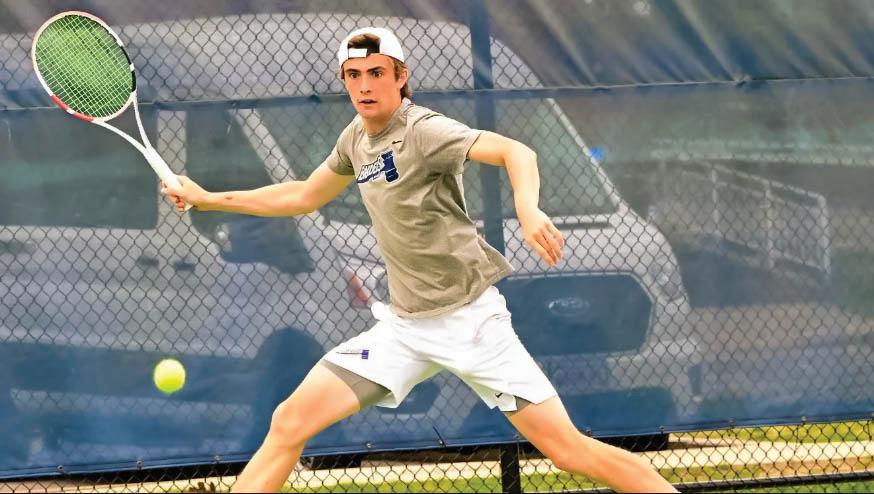
■ Despite a tough first match of the year, the team showed resilience, with Dylan Walters being named University Athletic Association Player of the Week.
By REMI YOUNG JUSTICE EDITORIAL ASSISTANT
The Brandeis University men's tennis team fought vigorously but ultimately lost 5-2 to Division I Bryant University in their spring 2025 season opener. Despite the loss, the Judges showcased resilience and individual excellence, particularly at the top of their lineup, with Dylan Walters MA 26 being named UAA Player of the Week.
Match Summary
200-yard butterfly Chloe Gonzalez '25 with a time of 2:15.70. 200-yard freestyle Jenna Wild '25 with a time of 2:06.50.
Brandeis (0-1) started the match with competitive doubles play. Walters, a graduate student and designated All-American, teamed up with Daniel Shemesh ’28 to secure a hard-fought 7-5 win at #1 doubles. However, Bryant (1-1) claimed victories at #2 (6-3) and #3 doubles (6-2), earning the crucial doubles point under the new one-point doubles system.
Despite the team's defeat, Brandeis fought back in the remaining matches. Shemesh battled to three sets at #3 singles but ultimately fell 6-2, 4-6
and 7-5. The Judges secured their two points as Walters prevailed at #1 singles in a grueling contest, winning 7-6 (7-5), 4-6, and 7-5. Aidan Wang-Fan ’28 added another victory at #4, rallying for a 3-6, 7-6 (11-9) and 7-5 triumph.
Walters Named UAA Player of the Week Brandeis standout Walters earned recognition for his performance, being named the UAA Men’s Tennis Player of the Week for the third time in his career. Walters was a double winner in the match against Bryant, securing victories in both singles and doubles. His singles win at #1 demonstrated his endurance, leadership and skill as he outplayed his opponent in three tough sets.
Walters, a first-team All-UAA selection in 2024 and a second-team honoree in 2022, made history last year as Brandeis' seventh All-American after advancing in the NCAA Division III singles tournament. His performance sets a high standard for the Judges as they progress through the season.
The Judges will take the next week to regroup before heading to Claremont, CA for their annual February break trip. They will play their next match on Feb. 16 against Scripps College’s Claremont-Mudd-Scripps, the #2-ranked team in Division III. With Walters’ leadership and young players stepping up, the men’s tennis team looks to make a strong performance as the season unfolds.
Brandeis 12
Notre Dame 25, Brandeis 2

Notre Dame 16, Brandeis 11 Penn State 16, Brandeis 11 Duke 21, Brandeis 6 NYU 14, Brandeis 13 Temple 22, Brandeis 5

Brandeis Skating Club continuing their tradition of weekly skates at Babson College and enjoying a fun winter pasttime.
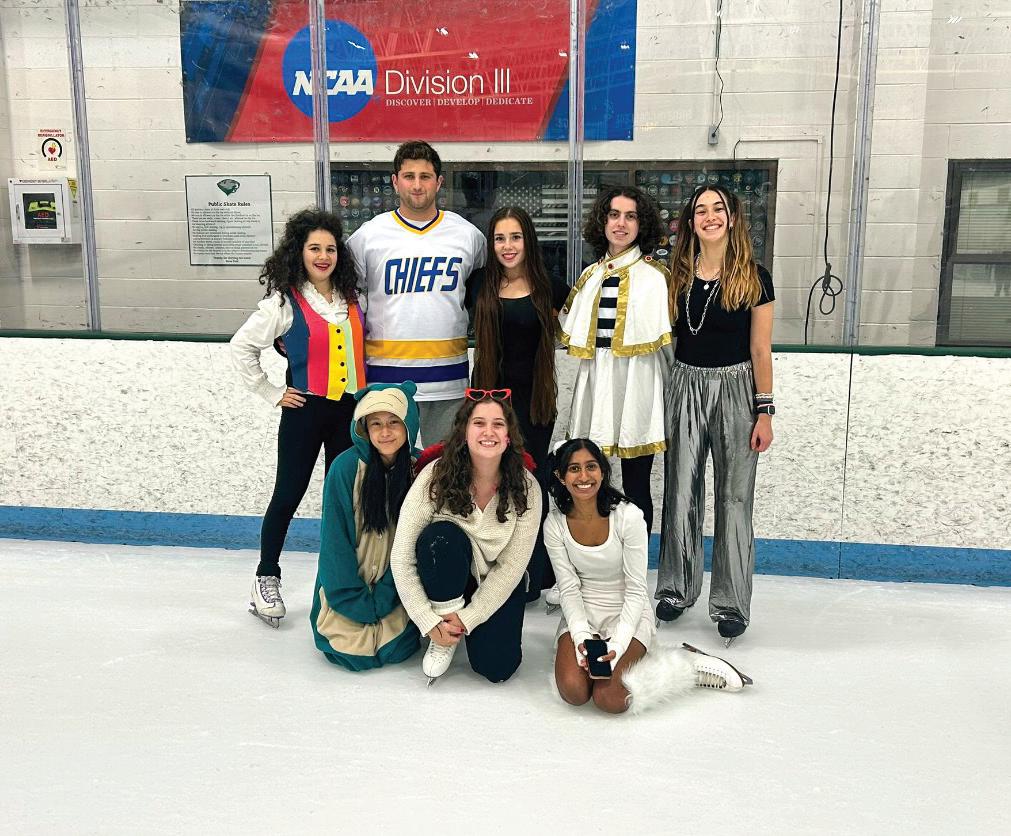



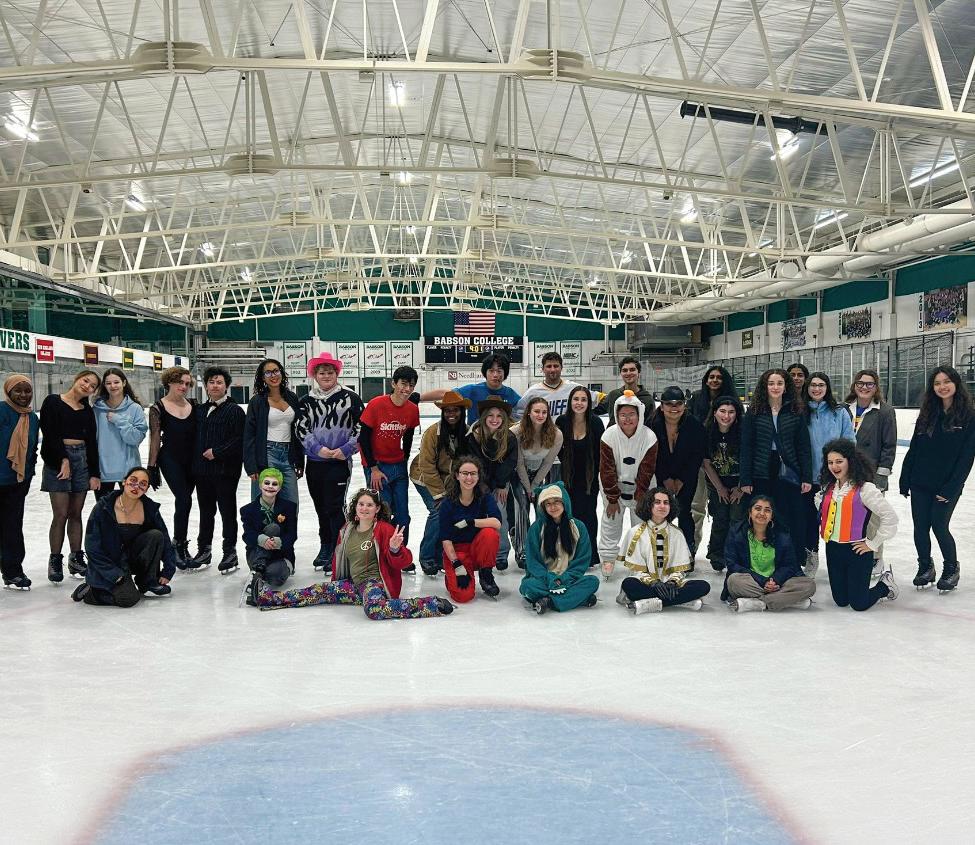

■ Chronicling the NFL’s signature event between the Philadelphia Eagles and the Kansas City Chiefs.
By EZEKIEL BLOOM JUSTICE STAFF WRITER
Well, there you have it. The Philadelphia Eagles are the 2025 Super Bowl champions! In a blowout 40-22 victory over the Kansas City Chiefs that saw them lead 24-0 at halftime, the Eagles were utterly dominant. They justified their National Football Conference Championship win a couple of weeks ago with another authoritative victory on the game’s highest stage. Eagles quarterback Jalen Hurts held down the fort, as his steady presence enabled the Eagles to ease in front without ever doubting the outcome. Hurts was cool and collected, evidenced by his 221 yards passing on 17 completions. He also threw for two touchdowns and gained 72 yards on the ground. The only statistical blemish on his night was an interception, but it hardly had any impact on the thrashing that the Eagles gave to the two-time defending champs. For his efforts under center, Hurts was awarded Super Bowl MVP, an accomplishment of major proportions that solidifies the 26-year-old’s NFL legacy. However, he still has many years to add to his collection of accolades, and Hurts will remain a major name in NFL football for years to come. Although Hurts shined with his MVP-level performance, the Eagles got much-needed contributions from across the board to ensure their victory on Sunday. Rookie cornerback Cooper DeJean chose the perfect time to catch his first career interception, which he took back for a touchdown to give the Eagles a 17-0 lead with about seven minutes remaining in the first half. Once Dejean’s pick-six occurred, the Eagle's victory seemed all but secured. This was further assisted by linebacker Zack Baun’s interception of Chiefs quarterback Patrick Mahomes on the Chiefs’ own 14-yard line with a couple of minutes left in the first half. This then set up a touchdown reception from Eagles receiver A.J. Brown to further balloon the lead to 24-0.
Even with their superstar running back Saquon Barkley struggling — 25 carries for 57 yards — the Eagles encountered almost no resistance from
the Chiefs, with their defensive plays powering their offensive success. Besides the two aforementioned interceptions by DeJean and Baun, the Eagle's defense forced a fumble and sacked Mahomes for a loss on six separate occasions. With the Eagles employing a stalwart defense anchoring a steady offensive attack, the Chiefs were powerless to overcome their early deficit.
Mahomes had a horrific night, as his 257 passing yards were greatly inflated by scores near the end of the game, which essentially served as consolation prizes. He turned the ball over on three separate occasions — two interceptions and one fumble — and looked completely out of sorts in the first half, only throwing for 33 yards. It was an uncharacteristic outing for the three-time Super Bowl Champion and MVP, who has historically thrived when the games matter the most.
Additionally, the Chiefs must go back to the drawing board as an organization to remedy what went wrong to foil their plans for a third consecutive Super Bowl victory. Veteran tight end Travis Kelce has hinted at this season potentially being his last.
The Chiefs have further pressing issues on both sides of the football that need immediate remedying if they want to remain contenders. They need more reliable options at receiver other than just standout rookie Xavier Worthy, and their defense was torn into shreds on the Eagles’ offensive drives. But with head coach Andy Reid confirming his return to the sideline next season amid retirement rumors, the Chiefs hope they can change their fortunes.
Lastly, I want to thank everyone for following these weekly recaps of NFL action. It is fairly remarkable that we started in early September, and this has extended five months into February. Hopefully, you all enjoyed following the exciting twists and turns that accompany the NFL season. But there’s no need to worry about what to do with your time now that the NFL season is over! The NFL offseason will commence over the next couple of months with the coming of the 2025 NFL Draft and the advent of free agency, so stay tuned for more football-related content in the time to come.
Events to watch: NFL Free Agency Period Begins: March 12, 2025 2025 NFL draft, April 24-26, 2025, Green Bay, Wisconsin.

The Justice Staff Writer Ezekiel Bloom '27 highlights Sunday's Superbowl between the Philidelphia Eagles and the Kansas City Chiefs, p. 12.
Tuesday, February 11, 2025


By EZEKIEL BLOOM JUSTICE STAFF WRITER
On the night of Saturday, Feb. 1, National Basketball Association fans were told of the most shocking news they had ever experienced over years of fanatical fandom. Luka Doncic, the 25-year-old superstar Slovenian guard for the Dallas Mavericks, a consensus top-five talent in the NBA and one of the league’s top stars, was traded in a blockbuster move to the Los Angeles Lakers.
The details of the trade are as follows: the Dallas Mavericks traded Doncicć, forward Maxi Kleber and forward Markieff Morris to the Lakers in exchange for Lakers forward-center Anthony Davis, guard Max Christie and a 2029 first-round pick. Most shockingly, the Mavericks gave no indication that their franchise cornerstone, a five-time NBA All-Star and All-NBA selection with career averages of 28.6 points, 8.7 rebounds and 8.3 assists, would be moved. Doncicćwas widely viewed around the league as an untouchable asset. Still, Mavericks general manager Nico Harrison apparently had his reservations about Doncic’s defensive abilities and his overall durability, with some injury concerns arising in the past few months. Harrison shockingly only spoke to Lakers general manager Rob Pelinka about the details of the trade and contacted no other teams about getting a potential return for an otherworldly player. The soured attitude on Doncicć is a great departure from previous Mavericks owner Mark Cuban, who was an avid supporter of Doncicć and infamously remarked: “If I had to choose between my wife and keeping Luka on the Mavs, catch me at my lawyer’s office prepping for a divorce.” However, Cuban sold his majority stake in the team in 2023, and evidently new ownership does not share his devotion to the superstar.
While the Mavericks are receiving a decent return in this trade in terms of a top-10 player in Davis and a competent role player in Christie, there are a couple of glaring issues in their negotiating process. Harrison emphasized that the Mavericks made this decision looking towards the future, despite Doncicć being only 25 while Davis is 31 with an extensive injury history that has consistently plagued him throughout his career.
Another significant problem was the Mavericks were only able to grab a single first-round pick from the Lakers, as L.A. did not even have to give up their available pick for 2031. Traditionally, trades involving NBA stars or superstars come with the stipulation that the team receiving the coveted player has to give a great deal in terms of draft capital. Mikal Bridges (a starting caliber player not in the same stratosphere as Doncic) was traded from the Brooklyn Nets to the New York Knicks this past summer at the price of the Knicks providing the Nets with a whopping five first-round picks! The fact that with that precedent, the Mavericks were only unable to collect one first-round pick for a player like Doncicć is utterly inexcusable.
It is extremely likely that the Mavericks will regret this decision in the future as an injury-riddled Davis faces the end of his NBA career while Doncicć begins to thrive, entering his prime in L.A. Mavericks fans can only hope that this trade does not go down as one of the worst in NBA history, as they lost a generational talent in his prime. Despite the greatness Davis has shown over the years, Doncicć is essentially irreplaceable in basketball terms, with the potential exception of the world’s best, such as Denver Nuggets center Nikola Jokić and San Antonio Spurs Center Victor Wembanyama. This is not even mentioning the philanthropic work that Doncic has done in the Dallas area with the Luka DoncicćFoundation and his deep love of the city and state, even wearing a cowboy outfit to one of his years a few years ago as an homage to the state he played in. In fact, Doncicć was about to close on a home in the Dallas area around the time the trade took place.
The loss of Doncicć has fallen especially hard on Mavericks fans, who have gravitated towards his awe-inspiring play and on-court personality since his debut as a rookie in 2018. Their displeasure and ire at management for the trade has resulted in allout protests being staged at the Mavericks arena (American Airlines Center). Fans were seen chanting “Nico sucks” in reference to General Manager Harrison for his role in the debacle of a trade. Ultimately, only time will tell if this trade ages horribly for the Mavericks, but Davis and Kyrie Irving are literally required to bring the team a championship because that’s the sole form of compensation that Mavericks management could provide to the fans who lost the soul of their franchise. As for Luka on the Lakers, LeBron James will ride into the sunset of his career playing alongside a remarkable talent, and Luka will usher in yet another era of Laker dominance anchored by a transcendent superstar.


TUESDAY, FEBRUARY 11,
T ell T hem i s T and for every T hing ‘ e milia P érez ’ does no T
“Emilia Pérez” has been called many things: offensive, tasteless, a regressive and stereotypical portrayal of the trans experience, heinous, the list of negative adjectives goes on. Despite this, the film is critically acclaimed and has recieved numerous accolades at Cannes Film Festival, the Golden Globes and the Critics Choice Awards, and multiple award nominations. The film is up for 11 British Academy Film Awards and three Screen Actors Guild awards. Most impressive of all is the truly baffling 13 Oscar nominations it has received, putting “Emilia Pérez” only one nomination away from joining “All About Eve,” “Titanic,” and “La La Land” as the most nominated films in Oscars history.
However in an Oscars race rife with controversy, “Emilia Pérez” is certainly the most contentious film thanks to comments made by director Jacques Audiard and the recently resurfaced offensive posts on X of lead actress Karla Sofía Gascón. Gascón’s posts have certainly garnered the most negative attention, so much so that, since their discovery, her awards campaign has dropped off the edge into freefall — hopefully dragging the rest of “Emilia Pérez” down with her as well. The posts are mainly from 2020 to 2021, and while I am not going to repeat any of what Gascón said here, the most succinct way to describe them is that for every minority group you can think of, there exists a truly hateful Gascón post about them. It is genuinely impressive the sheer amount of malice she holds for basically every ethnic group on the planet. Her hate did not just stop at minority groups, however. Gascón went after individuals as well, body-shaming Adele and ridiculing Selena Gomez, her now castmate. Thus, Gascón’s previous good press about being the first openly trans actor to be nominated for an Academy Award quickly dissipated. Though Gascón has since deleted her X account and apologized numerous times, it appears the damage has already been done. Netflix has announced they will no longer be paying for any flights, accommodations or styling for Gascón through the rest of the awards season. Audiard has publicly said he is no longer speaking with her, which feels an awful lot like throwing her under the bus, especially considering what he’s had to say about the film’s subject. This declaration seemingly falls perfectly in line with the indifferent attitude he has displayed in response to valid criticism of “Emilia Pérez” throughout this awards season. Despite “Emilia Pérez” being set in Mexico, the entire film was shot in France, primarily in a studio. When asked about this choice Audiard, also French, said that they did location scouting but ultimately the images he had in mind for the film “weren’t going to fit on the streets of Mexico.” Addressing criticism about the inauthenticity of the film, Audiard rebutted, “it might be a little pretentious of me, but did Shakespeare need to go all the way to Verona to write a story about that place?” He even admitted to not researching Mexico in preparation for making the film. He also called the film’s primary language, Spanish, which he does not speak, “a language of modest countries, of developing countries, of the poor and migrants.” Of the entire world it is estimated about 7.5% or 600 million people speak Spanish, and 500 million use it as their first language. Somehow, Audiard’s insensitive statements garnered far less mainstream press than the discovery of Gascón’s posts; however, they should not be overlooked. Personally, I believe Audiard’s repetitive, problematic and belittling statements about the cultural subject of his film should have been enough to place “Emilia Pérez” under serious scrutiny, but, evidently, we can’t all think like me. Finally, of the four main actresses in the film, only one is Mexican — Adriana Paz — and she is notably not up for any of the awards “Emilia Pérez” is lauded with. When asked about their casting choices, casting director Carla Hool said they had a ‘big search’ throughout Mexico, the United States and South America as whole, and despite being committed to ‘authenticity,’ they thought the cast they settled on was the best option for the roles.
Gascón is Spanish, Zoe Saldaña is of Dominican and Puerto-Rican descent and Selena Gomez is of Mexican American descent. With the exception of Gascón who plays the titular character, the character’s backstories were modified to fit their origins. Rita Mora Castro, Saldaña’s character was supposed to be Mexican but the film now explains that Rita’s family migrated to the Dominican Republic when she was young. Gomez’s character, Jessi, has a blink and you miss it throwaway line explaining she was born in the United States but moved to Mexico as a teen. It appears that despite com-
By MAEVE COAKLEY JUSTICE EDITORIAL ASSISTANT
mitment to ‘authenticity’ there was little issue in rewriting characters who previously had Mexican origins. Both Gascón and Gomez have had their Mexican accents criticized, but Gomez most especially. Mexican actor Eugenio Derbez called Gomez’s acting “indefensible” though he later apologized for the statement. Others have elaborated saying that her body language and tone do not match the words she is speaking. Gomez has become the source of many jokes online including a popular one that compares her Spanish line delivery to that of Emilia Clarke speaking High Valyrian in “Game of Thrones.”
The cast’s origins came under scrutiny because the film heavily revolves around the history of drug trafficking and cartel violence within Mexico. This contextual aspect of the film is another source of heavy criticism, especially in Mexico where “Emilia Pérez” was much more poorly received. Screenwriter Héctor Guillén found issue with the movie’s levity, his comments amounted to finding an operatic musical to be the wrong vessel for discussing “a drug war, [with] 500,000 deaths [since 2006] and 100,000 missing in the country.” Notably, neither Mexico nor the very real victims of violence the movie portrays, have been significantly mentioned in any of the acceptance speeches of those who worked on “Emilia Pérez.” Criticism further extends to the film’s portrayal of transitioning and the trans experience. The Gay & Lesbian Alliance Against Defamation called “Emilia Pérez” a “step backwards for trans representation” and a “profoundly retrograde portrayal of a trans woman” due to its “recyl[ing] the trans stereotypes, tropes and clichés of the not-so-distant past.”
But surely, one might think, despite all of this mess, 13 Oscar nominations is a big deal! The film must be brilliant or have some other redeeming quality! No. The film is also terrible. Even one Oscar nomination would have been too much for “Emilia Pérez.” I am fully serious when I say “Emilia Pérez” might genuinely be the worst film I have seen in the past year and I saw “Madame Web,” “Argylle” and “Irish Wish.” Now, is “Emilia Pérez” one of the worst movies ever made? Certainly not. However, I also did not leave the theater angry after “Madame Web” because I had just wasted precious hours of my life. I do feel that way about “Emilia Pérez.” I need the Academy to answer for the two hours and 12 minutes of my life I spent watching “Emilia Pérez” that I am never going to get back.
For those unfamiliar, “Emilia Pérez” follows a cartel leader who hires down-on-her-luck lawyer, Rita Mora Castro, to fulfill a lifelong dream of transitioning. In order to do so, Emilia Pérez fakes her death and sends her wife, Jessi, and their two sons away to live in Switzerland so that she may begin her new life post-transition — positioning transitioning as dying is one of those outdated regressive trans tropes GLAAD was talking about. Eventually, Emilia claims she was the sister of Jessi’s now late husband and brings Jessi and the kids back to Mexico as she misses them. Reunited with her family, the bored and wealthy Emilia feels she is living a purposeless life. On a whim she decides to found “La Lucecita,” a non-profit organization focused on finding the corpses of victims of drug-related violence and reuniting them with their loved ones. She brings Rita on as her partner in this endeavor. To be perfectly clear, much of the money Emilia uses to fund La Lucecita comes from the profits she made off the drug wars that were responsible for the deaths of the very victims whose bodies she is helping recover. She also uses her former connections in the criminal world of the cartels to help speed along the process of discovering the locations of the mass graves.
Before anyone gets ahead of themselves, Emilia does not create La Lucecita as a means of redemption or a way to offset the severe and prolific violence in her past. She’s doing it because she needs a hobby. In fact, the film positions her as no longer being responsible for her actions pre-transition because transition has literally made her a different person. Through transition she was entirely absolved of her sins and therefore divorced from any moral consequences from her time as an extremely successful cartel leader. Early in the film Rita has a line where she says “Changing the body, changes society. Changing society changes the soul. Changing the soul changes society, changing society changes it all!” At the time, I thought to myself that’s a strange thing to say! Little did I know it was to essentially become the film’s thesis.
I am not sure what kind of take on the transgender experience I expected from a film whose titular character flashes Rita to prove she’s on
estrogen but I guess it wasn’t that. The flashing incident occurs ten minutes into the film and Rita spends the following 15 minutes consistently misgendering Emilia. I mention the timing only because despite the problematic aspects, the first 30 minutes are the only remotely entertaining moments in the film. The first 30 minutes of “Emilia Pérez” are a mystifying and surreal experience during which you cannot possibly fathom what is going to happen next. By minute 31 you spend the rest of the film wondering when it’s going to finally be over. I promise you nothing interesting or new happens after minute thirty-one, except for the explosive ending, which was honestly kind of predictable so even that wasn’t vastly enjoyable. Visually, “Emilia Pérez” struggles to choose between a gritty dull thriller look and its bright, flashy, heavily choreographed and cut dance sequences. “Emilia Pérez’s” two different worlds, reality and musical, are in constant conflict with one another, creating a disjointing viewing experience. “Todo y Nada” and “El Mal,” the Oscar nominee for Best Original Song, both sung by Zoe Saldaña struck me as particularly jarring moments as the songs’ cutting and choreography clash so heavily with the visuals and story moments occurring on screen just before the songs began. “Emilia Pérez” made a myriad of aesthetic choices that failed to stick to a consistent theme resulting in numerous inelegant moments — one such being the cheesy splitscreen phone call moment during “El Trio.” A clip of “El Trio” went viral where it was heavily criticized due to “Emilia Pérez” receiving a nomination for best film editing. Anyone describing “Emilia Pérez” as audacious is correct. However a film possessing a bold new take does not automatically make it good. Furthermore, “Emilia Pérez” failed to convince me it needed to be a musical. Although the songs felt intentional in the beginning, their relevance quickly dissipated. Even the characters seem confused by having to sing, as a lot of the ‘singing’ is really more ‘speak-singing’ to an ambiguous rhythm. The whispering to a beat that occurs in some of the songs, such as “El Encuentro,” should hardly count as musicality due to its poor execution. This version of singing also added very little to the plot or style of the film. Rita speak-sings a duet with a doctor in Tel Aviv, called “Lady,” where bizarrely she tries to convince him to do a gender-affirming on Emilia Pérez, even though his entire job is to perform such surgeries. The song very easily could have been a conversation; it probably would have made more sense that way. However, I found this moment in the film to be the most ridiculous, so I will say that, in a soundtrack that lacks a single good song, it is my favorite. I would describe “Emilia Pérez” as a classic case of “you can’t have your cake and eat it too.” It needed to commit to either the story it was attempting to tell or the dramatic opera it envisioned its song sequences as emulating.
I would be remiss if I did not mention “La Vaginoplastia” after the first minute of the song went viral due to the infamous ‘from penis to vagina’ line. Rita is visiting Bangkok researching the best gender affirming surgeons and the doctor explains to her all of the surgeries they have available. This song also occurs within the first 20 minutes of the film and it is just as ludicrous as the clip implies it to be. If you were feeling persuaded to watch “Emilia Pérez” due to the absurdity exhibited in the “La Vaginoplastia” clip, don’t. It is the only song that exhibits such campy and fun energy. If all the songs were like that, I argue the film would have been vastly more enjoyable.
The single redeeming quality of “Emilia Pérez” is Zoe Saldaña’s performance. She was acting like her life was on the line and she has a really amazing voice to boot. Her character’s reactions to the almost unbelievable world she finds herself a part of are sometimes amusing. Her presence is so fundamental to the film, I believe she should be the one campaigning for best leading actress instead of Karla Sofía Gascón. But alas awards season category fraud is the least of “Emilia Pérez’s” problems. Unfortunately Saldaña’s presence is not enough to offset every other aspect of the film and is certainly not justification for the accolades “Emilia Pérez” has thus far received.
This all begs the question: if “Emilia Pérez” is so terrible, why is it receiving so much awards recognition? Why is it receiving thirteen Oscar nominations in particular? This year’s Oscar nominations were perceived as snubbing several deserving films such as “Furiosa: A Mad Max Saga,” “Longlegs,” “Challengers” and “I Saw The TV Glow.” “Emilia Pérez’s” numerous nominations over other films left many
confused. In response to Luca Guadagnino receiving zero Oscar recognition for either of his critically acclaimed 2024 films, “Challengers” and “Queer,” one individual on X asked, “did luca guadagnino kill somebody?” A sentiment I have to agree with because, at this point, I honestly have no other reasonable explanation as to why Guadagnino has yet to receive Oscar recognition as a director.
Unfortunately, there is one simple reason for “Emilia Pérez’s” success, it is exactly the sort of faux-progressive film the Academy loves to nominate and then pat themselves on the back for. It is no secret that we are rapidly swinging backwards into an increasingly conservative culture. Our current sitting president has made trans people and Hispanic people, but especially Mexicans, the target of much of his vitriol. The rhetoric he and members of his party continue to apply to both minority groups remains increasingly alarming. “Emilia Pérez” feels like a senseless way for the Academy to declare that is not what they stand for. If this is truly the motivation for the Academy’s recognition of “Emilia Pérez” it is a disappointing but not surprising one. If the Academy wanted a film about the trans experience they could have just as easily picked “I Saw The TV Glow,” which received praise for its use of a trans allegory and was made by Jane Schoenbrun, a trans nonbinary filmmaker. Martin Scorsese called the film, “emotionally and psychologically and very moving.” If the Academy was truly searching for a way to uplift Mexican culture, they surely could have chosen better than a film hellbent on sentimentalizing and trivializing the pain caused by cartels and cartel drug wars in Mexico — especially not a film whose director has made such dismissive comments about the very country and culture he was portraying. “Emilia Pérez” and its controversy can be likened to past Best Picture winners “Green Book” in 2019 and “CODA” in 2022. Both films also sparked heavy debate regarding their representation of minority groups but still managed to win despite pushback. Some may say this is a good omen for “Emilia Pérez’s” chances to win at the 97th Academy Awards. I would rather we wait and see if the recent controversy surrounding Karla Sofía Gascón impacts results at the BAFTAs and SAG awards, which are often seen as indicators of which films will go on to win Oscars. The voting windows for both the BAFTAs and the SAG awards had yet to close when Gascón’s posts were discovered, unlike the Critics Choice Awards whose voting window closed prior. We can only hope that the Academy chooses to stop celebrating such blatant prejudice and poor filmmaking, but they’re the Academy so I won’t hold my breath. You can be certain of one thing if “Emilia Pérez” wins a single Academy Award, I will have wasted seven dollars paying an Etsy witch to hex the cast and crew.
If there is any justice in the world “Emilia Pérez” won’t win a single award at the Oscars. Between the film’s wretched execution and the beliefs of certain members of cast and crew, it is my opinion that it doesn’t even deserve its nominations. Still, I will be the first to admit that very rarely have I walked away from a livestream of the Academy Awards believing every win was deserved. However, in my humble opinion below is who I would have nominated for every category in place of “Emilia Pérez.”
1. Actress in a Leading Role: Zendaya, “Challengers.”
2. Actress in a Supporting Role: Margaret Qualley, “The Substance.”
3. Cinematography: Stéphanie Fontaine, “Conclave.”
4. Directing: Luca Guadagnino, “Challengers.”
5. Film Editing: Marco Costa, “Challengers.”
6. International Feature Film: India, “All We Imagine as Light.”
7. Makeup and Hairstyling: Eva Von Bahr and Love Larson, “Dune: Part Two.”
8. Music (Original Score): Trent Reznor and Atticus Ross, “Challengers.”
9. Music (Original Song): “Compress / Repress” by Atticus Ross and Trent Reznor, “Challengers.”
10. Music (Original Song): “Forbidden Road” by Robbie Williams, “Better Man.”
11. Sound: James Harrison, “Blitz.”
12. Writing (Adapted Screenplay): “The Room Next Door,” Pedro Almodóvar.
13. Finally, in the spirit of Academy collaboration, I polled all of my film buff friends and here is the list of films they would have nominated for Best Picture instead of “Emilia Pérez”: “Sing Sing,” “Better Man,” “Longlegs,” “Challengers,” “Nosferatu,” “I Saw The TV Glow” and “Didi.”
By ANNA MARTIN JUSTICE EDITOR IN CHIEF
Content warning: This article discusses sexual abuse and childhood trauma.
n The format of documentaries is not as strict as one might think. The integration of home videos allows for further context and deeper audience empathy.
The usage of found home video within documentary films can be a very effective editing strategy, replacing less impactful B-roll and expanding the availability of audio clips, which reduces the need for recorded narration. This strategy provides more content, which in turn adds context and depth to the story being told by the journalist. The documentaries “The Family Album,” “Minding the Gap” and “Rewind,” three pieces exploring growth and familial relations, are all great examples of this strategy. While the same editing technique is used, each of these documentaries incorporates home video footage in a unique, impactful way.
“The Family Album” uses home videos as the primary source of footage when telling a chronological story. This documentary begins by showing the children of a family from found footage from the 1940s. The documentary follows these children through all of the ups and downs of their lives as documented by their families over the next 10 to 20 years. The documentary used a chronological format in order to illustrate a story of growing up in the United States in the mid-20th century. From the first scenes of young children, the audience watches these individuals grow into adult life, with a section focused on weddings, unity and the joining of families. The documentary also covers death and loss in its conclusion.
In “The Family Album,” the reliance on home video as a narrative tool was appropriate. It allowed the audience to become attached to the subjects that the documentary was focused on, and watch them grow while hearing their voices and learning about the trajectory of their lives. An interesting aspect of this documentary was the way in which the footage was manipulated. In the other two documentaries I mentioned, home video was inserted unedited, purely for the purpose of providing context to present day issues being discussed. In “The Family Album” however, some of the footage was presented in a sped up manner, showing the passage of time. This was a very interesting technique, as it represented how editing can convey deeper messages and concepts to the audience. The music used also contributed to this concept, as when the footage was being played in fast forward, fast background music further enforced the idea of the passage of time.
In subtle contrast, both “Minding the Gap” and “Rewind” used the technique of inserting home footage to provide context to specific ideas being discussed by current day characters. This is interesting, as it compares current opinions and knowledge to moments of the past, allowing the audience to examine all sides and form an opinion for themselves. It increases the legitimacy of ideas presented, as it provides historic primary evidence. Utilizing home footage in this manner can also be an effective strategy in gaining empathy from the audience, especially in the case of documentaries that are centered around stories from the childhoods of the subjects.
“Rewind” stands out because there was a third element to the documentary in addition to the home video and the current footage such as interviews with family members. There was the integration of artifacts that had been held from a previous time. Some of these were held by Sasha’s mother, such as a mask that he wore over his face. The rest of these artifacts were held in binders kept at the office of his previous psychiatrist. In a scene shown at 31:43, they went through these binders together and discussed the different drawings from different points through Sasha’s
childhood. The psychiatrist explained that when working with children affected by trauma, words aren’t always the most effective strategy when trying to communicate both what happened and what they are feeling. In these instances, they often ask the children to draw instead.
In the documentary, Sasha and his past psychiatrist sat down together to review the drawings that he had produced when he was a child. They found the drawing that was used to identify his abuser. This was a very emotional experience, as the age of the child can be clearly identified through the style and complexity of the drawing. The documentary balanced the psychiatrist speaking about traditional practices and approaches taken in circumstances such as these while also connecting with Sasha on a personal level when reviewing these artifacts.
Having these artifacts of the past balanced with the home video footage allowed for a connection to be built between these two time periods. The previous time displayed connects to the present through the present observation of relics of the past. This was a very effective strategy, as a common problem that is often presented is a lack of cohesion when jumping back and forth from the past to the present. This can leave audience members struggling to follow or understand what is important to be keeping track of. The use of this in-between strategy allowed the audience to gain a clearer understanding of what was important and proceed watching the rest of the film with a more well rounded sense of both the past and the effect that it has had on the present.
One more element that was different among these three documentaries was the person behind the camera. This small difference created three different tones with three different messages being shared.
“Minding the Gap” was more of a biopic, as both the current footage and the footage of the past were both being filmed by the subject of the story. This created a point of view that the audience was experiencing, and allowed the subject to share the story that he wanted to about his own life.
“The Family Album” was a compilation of footage filmed by many different people over the course of decades. This provided a well-rounded view of the entire family and allowed the filming to take place over a longer period of time. The use of multiple perspectives allowed the documentary to become a piece of history, as it was not just focused on one person or one thing. Instead, it was a symbol of growth and progress as time passed and the children shown in the beginning began lives and families
of their own.
“Rewind” was more of a combination, as there was a film crew that captured the current day footage. This allowed the subject of the documentary to be experiencing everything fully in front of the camera, as opposed to “Minding the Gap,” in which he was behind the camera creating a point of view. In “Rewind,” the audience is an outside observer learning about a situation of the past. Most of the home footage was filmed by Sasha’s father, a survivor of assault by the same people as him. When watching the documentary for a second time, this provided an interesting perspective. The abusers were never documented by anyone that they had not harmed. Sasha’s mom spoke about how she felt that this home documentation had torn her family apart, as her husband never came out from behind the camera. His mother and father proceeded to get a divorce. Sasha’s father expressed his discomfortwith watching the home videos that he had shot. Bing Liu from “Minding the Gap,” did not seem to hold this sense of discomfort, as he made the active choice to use his own footage when creating a documentary about his past and his community.
An article in the New York Times states “people historically shot home movies to remember happy occasions, not to capture bad ones.” This statement is an interesting one, as “Rewind” was shot with this intention, trying to capture fun family memories and moments. However, circumstances changed the tone of these videos, allowing them to have an eerie and uncertain air to them. “The Family Album” aligns with the message of this quote, in that the home movies were used to capture all of the special family moments such as birthday parties and weddings. While this was enjoyable to watch, the audience is missing some context. No family is perfect, they just often chose not to document the negative. “Minding the Gap” was the most neutral of all three of these documentaries, as it seems that Bing Liu documented everything, the good and the bad. The home video was used purely to provide context when needed, without reservations due to family image. Comparisons between the intended versus actual use of home video can be made for each project individually, and are not the same.
Utilizing previously filmed home videos and integrating it into documentaries about childhood, family and growth is a very effective strategy. It can be used to provide context as well as build the connection between the audience, the filmmaker and the subject.

TUESDAY,
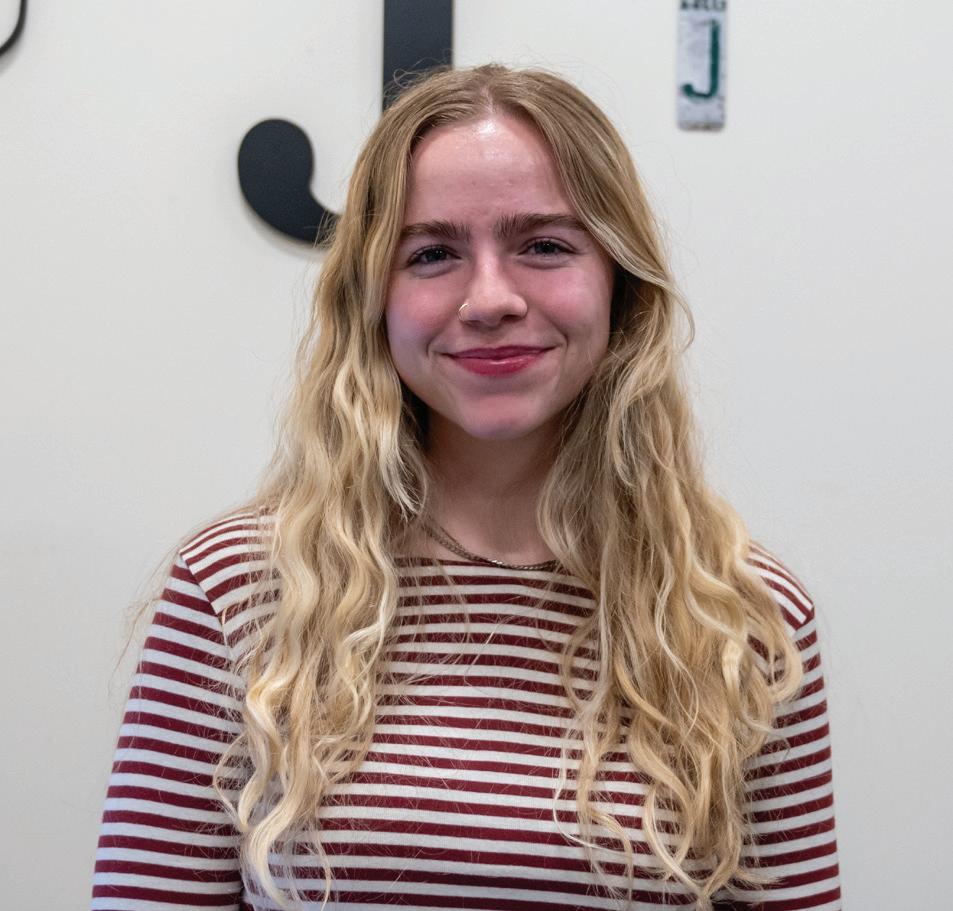
By BRIANNA EARLE JUSTICE EDITORIAL ASSISTANT
1. “Hannah Montana (The Movie)”
2. “Cloud 9”
3. “Lemonade Mouth”
4. “Sky High”
5. “Halloweentown”
6. “High School Musical 2”
7. “Let it Shine”
8. “Camp Rock”
9. “Princess Protection Program”
10. “The Cheetah Girls”


